
Introduction
“Yes, madam, I am finished. My star has fallen. I have no fight left in me. I work and I try, yet know that all is but a farce… I await the end of the tragedy — and, strangely detached from everything, I do not feel any more an actor. I feel I am the last of spectators.”
— Benito Mussolini in an interview with Madeleine Mollier, 1945
This book is for those who understand that politics is not just something happening on the news — it has a direct and personal impact on their lives, their future, and the opportunities available to their children. This book provides astrological predictions for various countries. You will gain insight into which regions are likely to remain stable and secure in the coming years-and which may face turbulence.
The events of the past five years have made it clearer than ever: the decisions made by world leaders do not just shape economies and governments — they affect the everyday lives of ordinary people in profound ways.
It all began with the COVID-19 pandemic, when world leaders shut down businesses, put much of the population out of work, pushed much of the economy online, and separated families-many of whom never had a chance to reunite before the lockdowns hit. COVID, along with the decisions made by governments, reshaped everyone’s lives in ways we could never have imagined.
The events of 2022, 2023, and 2024 have made one thing undeniably clear — the place you live and the passport you hold are more than just bureaucratic details. They shape your opportunities, your freedom of movement, your financial stability, your relationships, and even your personal safety.
We rely on political and military experts to make sense of unfolding global events, and we use their analyses to form our own perspectives on the future. But astrology offers a deeper, more structured way of predicting what lies ahead.
In this book, I make predictions from the perspective of professional predictive astrology to assess the world’s key decision-makers. Use these insights as another lens through which to analyze global trends, evaluate possibilities, and test your own predictions about the future.
This book is full of hidden meanings, thought-provoking insights, and puzzles woven between the lines — details that will catch the eye of any astute reader. You will see how astrology reveals the secrets of governments and explore a number of fascinating predictions about today’s world leaders.
My track record in predictive astrology includes many forecasts that have already come to pass — Biden’s presidency, Trump’s two election victories, the end of the COVID-19 pandemic, instability in Ukraine, intensifying conflicts in Israel, the shift of power in Germany, and more.
I hope that my experience and expertise will help you cut through illusions, dispel unnecessary fears, and approach the future with greater clarity and confidence.
Astrology of Power: What Defines a Politician?
Power is both alluring and absolutely devastating. Once someone has tasted it, they can never truly return to who they were before. In this chapter, I will present the astrological foundation behind this phenomenon.
Certain key features in a politician’s birth chart indicate a strong drive for authority and governance. One of the most telling factors is the prominence of specific nakshatras. A nakshatra is a sector of 13 degrees and 20 minutes, which is typical in the Indian astrological coordinate system.
Such nakshatras as Swati, Satabhisha, and Ardra frequently appear in the birth charts of politicians. Swati spans from 6° 40′ to 20° 00′ Libra, Satabhisha stretches from 6° 40′ to 20° 00′ Aquarius, and Ardra extends from 6° 40′ to 20° 00′ Gemini. All three are ruled by Rahu, the North Node of the Moon.
Rahu represents an intense drive for material success, an insatiable hunger for social fulfillment, and a deep-seated craving to enjoy the privileges of power and high status in life.
It has nothing to do with spiritual life. Rahu is highly practical, materialistic, and endlessly ambitious. In the astrological charts of ordinary individuals, Rahu is often associated with addiction to alcohol and drugs.
The ancient Hindus depicted the North Node of the Moon as the severed head of a demon with bulging eyes and an insatiable mouth, endlessly devouring everything in its path. This striking imagery is no coincidence — Rahu and Ketu, the lunar nodes, are closely tied to eclipses. During a lunar eclipse, Rahu is said to “swallow” the Moon, momentarily stealing its light and casting a shadow over the Earth.
Yet, Rahu can never be truly satisfied, always yearning for more. According to legend, because its head was severed from his body, anything it consumes simply spills out through the broken neck.

Power, personified by the demon Rahu, perfectly embodies its own essence. Everything is sacrificed in its name, but it is not enough. No matter how much power is accumulated, it slips away, leaking endlessly through the open wound. Power devours the man himself, his relationships with loved ones, children, affection and friendship.
The man who enters the gates of greatness bearing only his intangible riches leaves that city with a shattered fortune — but clothed in robes of gold.
Power succession is one of civilization’s greatest achievements, safeguarding against Rahu’s destructive influence on both ruler and nation.
When the principle of succession is violated, it leads to the inevitable downfall of both the ruler and his people. Even if the consequences are delayed for decades…
In the birth charts of politicians who do not change for decades, Rahu almost always stands as one of the dominant planetary forces.
The first indication of a political birth chart is the presence of planets in the nakshatras Ardra, Swati, and Satabhisha, as all three are under the symbolic rulership of Rahu. During the planetary periods of these planets a person will develop an interest in politics or become actively involved in it.
The second key indicator is the presence of planets near the royal stars, associated with success, prestige, and honors.
Among these, the most influential for a political birth chart are Spica, Regulus, and Antares. Politicians with these stars prominently placed in their charts tend to wield the greatest power and influence.
As we move through this book, we will analyze multiple birth charts, exploring the unique characteristics and significance of each of these stars in shaping political figures.

Below is a list of 12 stars that strongly influence political power and recognition:
— Aldebaran;
— Rigel;
— Polaris;
— Betelgeuse;
— Sirius;
— Regulus;
— Spica;
— Arcturus;
— Gemma;
— Antares;
— Altair;
— Deneb Algedi.
Around Spika, the most powerful in the entire sky, the ancient Hindus allotted Chitra Nakshatra. Its symbol — a diamond or a pearl — perfectly reflects its essence. This nakshatra is linked to those who have access to luxury and whose life involves opportunities to study art, culture of nations.
Chitra is one of the nakshatras that indicate a natural inclination toward leadership and holding positions of authority in society. Its ruler is Mars, which sets it apart from the Rahu-ruled nakshatras that we discussed earlier. I specifically want to highlight that its influence is shaped by Spica, rather than the fictitious point of Rahu.
The nature of Spica and Chitra Nakshatra is noble, intelligent, and refined, representing a form of power that is thoughtful, cultured, and tied to luxury and high status. This is not the chaotic and insatiable energy of Rahu but rather an inherent aristocratic quality. Often, this influence manifests quite literally — people with an active Chitra Nakshatra are either born into privileged social circles or rise to them through the course of their lives.
A prime example of such a birth chart is Boris Johnson, who has an Ascendant at 29 degrees 36 minutes of Virgo. When Johnson was born, the star Spica was rising in the East, and the nakshatra Chitra became the starting point of the whole birth chart.
Case Study 1. Boris Johnson
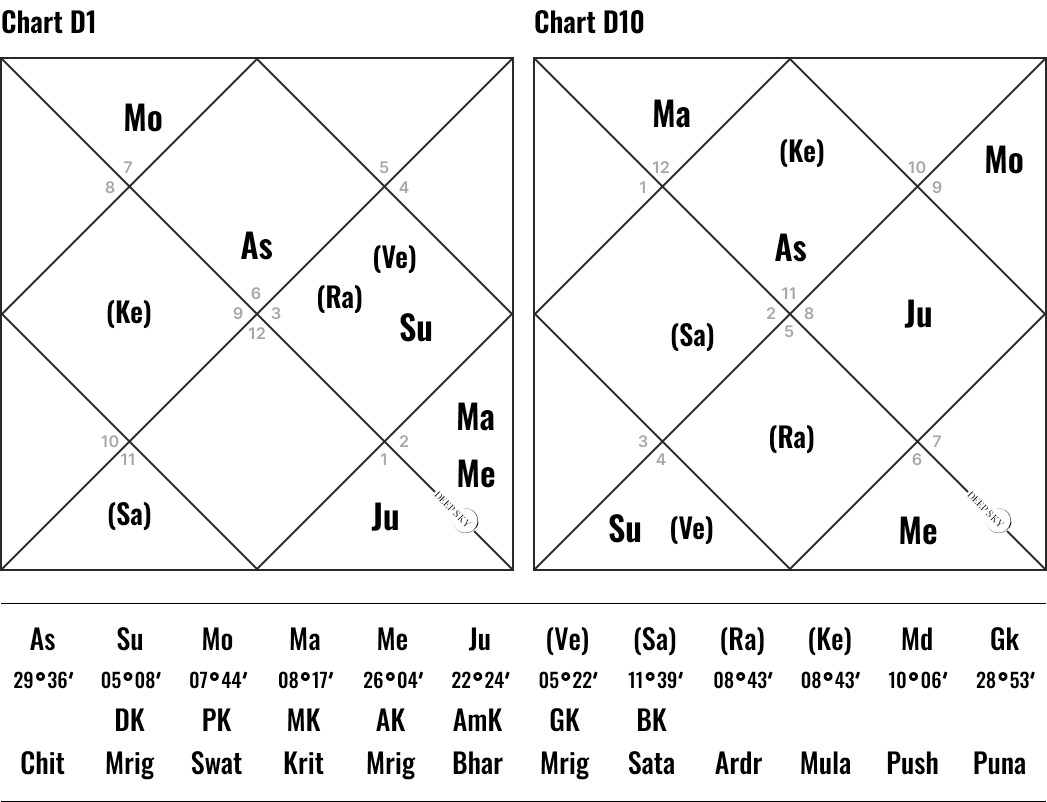
Boris Johnson’s paternal great-grandfather, the Turkish journalist Ali Kemal, was briefly Minister of the Interior in the government of Ahmed Tevfik Pasha, the last Grand Vizier of the Ottoman Empire. During his tenure, he issued an order for the arrest of Mustafa Kemal Atatürk.
The great-grandmother of Boris Johnson, Baroness Marie-Louise von Pfeffel, was the granddaughter of renowned chess player Jules Arnous de Rivière, the great-granddaughter of Duke Paul Wilhelm of Württemberg, the grandniece of Grand Duchess Elena Pavlovna, and the niece of Baroness Ernestine von Pfeffel, the wife of poet Fyodor Tyutchev.”
Boris Johnson’s maternal great-grandfather was the American paleographer Elias Avery Lowe. His maternal great-grandmother was Helen Tracy Lowe-Porter — an American translator of prose fiction. He is also a distant descendant of King George II. That is what it means to be born under a lucky star that denotes aristocratic roots!
The third key indicator of a leader’s birth chart is a strong Jupiter positioned in the first, fourth, seventh, or tenth houses — in other words in Kendras. Jupiter is the planet of speakers, ideologues, and skilled orators. It grants the ability to communicate profound ideas, articulate global visions, and develop long-term strategies. Without strong Jupiter’s influence, it becomes much harder to convey big-picture thinking and gain the trust of the people.
Case Study 2. Mikheil Saakashvili
Mikheil Saakashvili is a politician with a powerful Jupiter. This planetary strength enabled him to implement large-scale reforms in his country and gain authority not only in Georgia but also across the Commonwealth of Independent States (CIS) as a whole.
Saakashvili’s birth chart teaches us a crucial lesson: power and influence are granted for a limited time. A politician may rise to leadership during a favorable period, and in other periods he may be left with nothing because his period of glory has literally passed.
The peak of Mikheil Saakashvili’s success occurred during his Mars period, which began in 2009 and lasted until just after the completion of his second presidential term in November 2016.
Afterward, he gained political influence and support in Ukraine, but on September 29, 2021, he returned to Georgia to oppose the ruling government. His arrest followed swiftly.
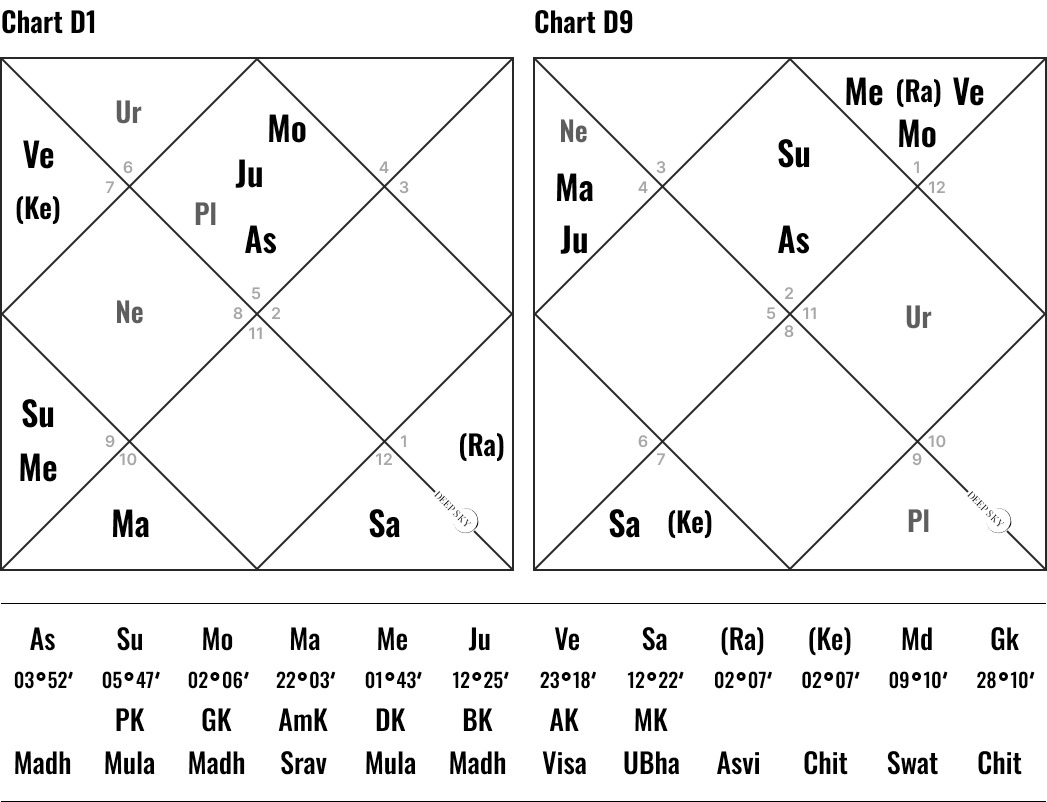
From an astrological perspective, his downfall was inevitable. The Mars period that once elevated him to the presidency had ended in 2016, and now Rahu, which ruled the astro chart in 2021, had deceived Saakashvili.
Let me remind you that Rahu is a demon, a chimera. He has no physical form like the Moon, stars and other planets do. It lures a person into reckless actions, deceiving them with inflated expectations of the future. But in reality Rahu does not exist in a physical sense — it is just a shadow.
During an eclipse the shadow of the Earth passes over the Moon, creating the illusion that the Moon has disappeared. Saakashvili fell into the same illusion — he believed that the risk of arrest was not such a big deal; he truly believed that people would stand tall for him and carry him on their shoulders straight to the presidential palace.
But they did not. At least, not in the way he had hoped — not with the strength and determination that we see in 2024 and 2025, when the regime has grown so oppressive that public resistance has become inevitable.
Now Saakashvili is in prison, and it is not until 2027 that there is any hope of him being exchanged and going abroad.
What is the takeaway? A ruler is invincible only for as long as fate shields them. But once that protection fades, any politician can be thrown by fate to the wayside, and it is lucky if that wayside is comfortable enough.
Before attempting to seize power on a wave of popularity, one must think carefully, estimate the time, place, and circumstances. The period of time under the opportunity to gain power is usually extremely short, and in the scale of life is minuscule, it is about 3—9 months.
But let us return to the key indicators of a political birth chart. One of the most crucial factors is the presence of Saturn in a prominent position. For a public leader, Saturn must display signs of power — it should be in the royal sign of Leo, exalted in Libra, or hold the position of Raja Yoga Karaka. Such placements are highly favorable for a politician’s fate, often extending their time in power for many years.
Authoritarian leaders often have exalted Saturn, while representatives of democratic political systems have Saturn in its sign.
At the beginning of this book, I noted that the birth charts of presidents are mystically linked to the karma of their nation.
For the term of office, the astrological chart of the leader conducts through itself the karma of the country and merges with it. The more a country tends to be democratic — the less fusion of fates. When the state tends towards totalitarianism — the mutual penetration becomes stronger.
Authoritarian and totalitarian leaders, who shape the government solely according to their own will and concentrate all key branches of power in their hands, tie the fate of the nation directly to their own birth chart. The course of events in the country becomes a reflection of their personal planetary cycles and transits.
This means that, even without knowing the form of state government, we can determine a leader’s governing style simply by analyzing their birth chart along with a few key facts about the country they rule.
In the following chapters, we will make astrological predictions for Xi Jinping, Donald Trump, Benjamin Netanyahu, Recep Tayyip Erdoğan, and many other modern world leaders.

Leader and Nation: An Unbreakable Bond
The Bible says that every nation gets the leader it deserves. I tend to agree — a country’s destiny calls for a particular type of leader, and that request is always fulfilled.
A national leader never emerges from nowhere; their personality reflects the country’s most pressing expectations and trends. A country calls for a specific leader, and the one who fits best rises. When expectations shift, the leader changes too.
Yesterday it might have been a member of the ruling elite; today — someone from the working class; tomorrow — a successful businessman. What matters is that the country’s demand always aligns with the leader who rises to power.
During a leader’s time in power, the houses in their birth chart take on national significance. What once reflected personal matters now governs state affairs. The seventh house, which previously indicated partnerships in personal life, changes after an election, signifying relations with other world leaders, diplomatic alliances, and the country’s reputation on the international stage.
The second house of money before an election represents a leader’s personal finances, but after inauguration it reflects the financial capacity of the entire state. The amount of wealth indicated in the leader’s birth chart during their time in power directly influences how much money they will be able to attract to the country — or, conversely, how much may be spent.
The more authoritarian and absolute the regime, the stronger this dependence becomes. In democratic nations, the connection between the leader’s fate and the country’s destiny is less direct. At times, this connection feels almost mystical — a ruler’s birth chart reflects all major events that will unfold in the country during their time in power.
Turn to the natal chart of George VI, which ruled England during World War II.
Case Study 3. King George VI
In the birth chart of the King of the United Kingdom and the British Dominions the Aries period began on December 15, 1938. Aries is ruled by Mars, the planet of war, which in his chart was placed in the eighth house — the house of crises, stress, fear, and danger.
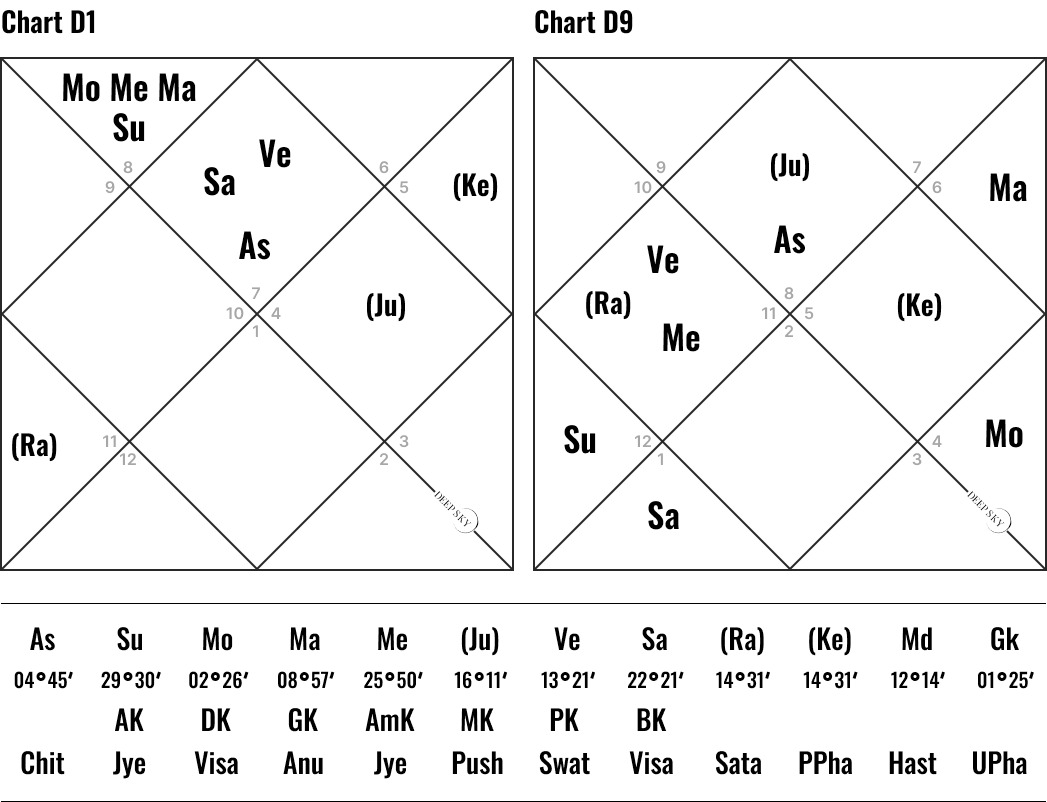
A cluster of four planets in the warlike sign of Scorpio, positioned in the eighth house of crises, strongly indicates that this period will be marked by conflict, stress, and matters of life and death.
In the seventh house of international relations, Saturn appears next to the star Zubenelgenubi or the Southern Claw, suggesting the following definition: “Harsh and unforgiving justice, a reckoning for human error, restoration of a disrupted balance, emphasizing the inescapability of punishment.”
Do you know when the Aries period ended in George VI’s chart? December 14, 1945. This means that from 1939 to 1945, the birth chart indicated that the ruler of England would face a period of trials and crises.
Does not this remarkable case demonstrate that professional predictive astrology can, in fact, illuminate the course of world events?
Now, let us turn to the planetary transits in the sky at key moments, as they relate to the birth chart of King George VI of England.
But before we dive into the transit analysis, it is important to briefly explain how this technique works.
Every person carries a cosmic passport — their birth chart, calculated for the exact time and place of their birth. This chart is a snapshot of the heavens at the precise moment life begins.
To understand how an individual’s fate interacts with the outer world, let us use the analogy of a music box.
The metal comb of the music box represents the natal chart, fixed within a person’s consciousness. Each day, we engage with the ever-changing rhythm of planetary motion, just as the rotating drum of the music box strikes the prongs of the comb.
We “cling” with the protrusions of our psyche to the current position of the planets in the sky, from which our reactions, actions, decisions and the events we experience in the outer world.
Now, let us return to the birth chart of King George VI, the monarch of the United Kingdom of Great Britain and Northern Ireland at the time of the outbreak of World War II.
Case Study 4. Transit to the Onset of World War II
The Moon, which signifies a person’s thoughts, mood and state of mind, was positioned in the sixth house of conflicts and confrontations of the King on that ill-fated day of September 1, 1939.
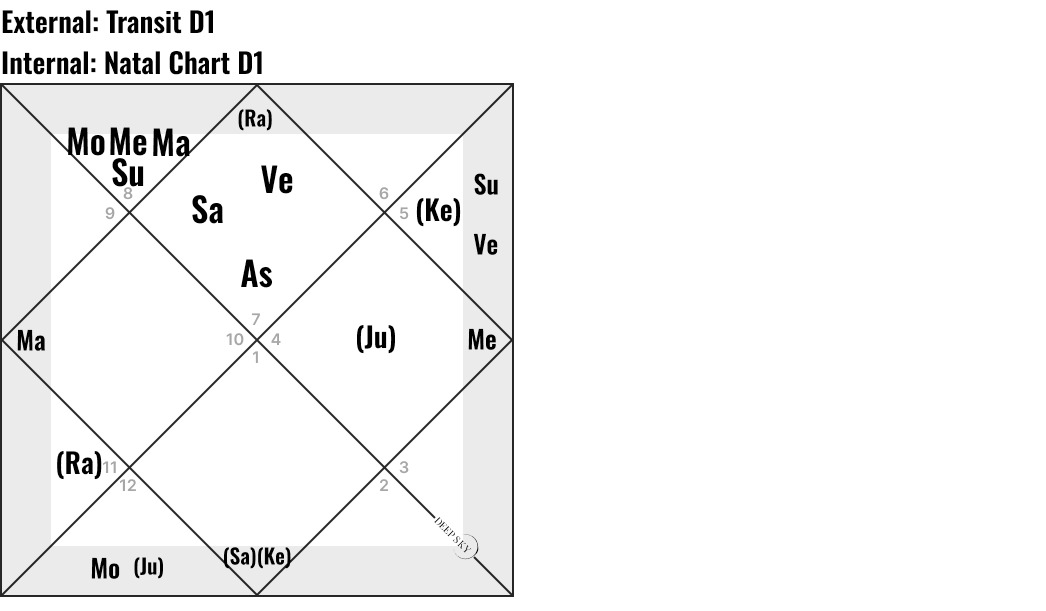
The seventh house of international relations was affected by Saturn and Ketu in transit. These are the two worst malefic of all the planets in the astro chart, and in the first weeks after the outbreak of war, they both affected the seventh house of the King of Great Britain.
The planet ruler of the fourth house of the Homeland, which is the most sensitive point of the natal chart for the leader, was at that moment in the sign of its fall, which foreshadowed the inevitable raids of the enemy on the cities of England.
Mars — the planet of war — was transiting through the fourth house of George VI’s homeland. This was yet another omen for the King — a warning of the approaching German forces.
Mars was in its full strength, exalted in Capricorn.
Exaltation is a unique planetary condition in which a planet appears more powerful than it truly is. It is similar to moments in human life when we feel “on fire” — performing far beyond our usual capacity. This is the nature of exaltation: its results are brilliant, but unstable.
At the outbreak of World War II, Mars was in exaltation — a placement that signaled a formidable enemy, one who seemed stronger than he actually was. The plan for a swift, powerful strike succeeded at first, but could not be sustained — Germany became entangled in a long and exhausting war.
At the same time In George VI’s chart, the Sun (the planet of work duties) and the ruler of the first house of personality were transiting through the eleventh house of alliances — a clear sign that it was the right time to form a military coalition and unite forces against the enemy.
Houses in the Birth Chart of a Politician: Meanings
First house. The nation’s health and overall well-being. Represents key events affecting the entire country, including epidemics, wars, and mass protests.
Second house. The country’s financial life. Economic crisis, periods of prosperity, sanctions that apply to the country.
Third house. Relations with neighboring countries. Signing of important agreements, diplomatic negotiations, trade agreements, and border policies.
Fourth house. Homeland, national infrastructure, transportation, internal security.
Fifth house. Leadership status, influence, and public approval. Indicates political success, strategic decision-making, popularity.
Sixth house. Public unrest, protests, national healthcare, military affairs (rearmament, internal conflicts), and legal matters, including international sanctions and criminal prosecutions. Participation in elections, confrontations and contests.
Seventh house. The nation’s reputation on the world stage. Governs foreign relations, alliances, international diplomacy, and the leader’s interactions with global figures. Relationship with members of the president’s office and ability to assemble a strong team.
Eighth house. Crises, wars, natural disasters, national emergencies, and high mortality rates. Also signifies foreign investments, economic dependencies, attracting funds from partners and allies.
Ninth house. Diplomacy, position in the international arena, diplomatic successes of the country.
Tenth house. Legitimacy and effectiveness of leadership. A real-time indicator of government efficiency, his ministers and the office as a whole, political stability.
Eleventh house. Political alliances, unions, and coalitions. Achievements and prestigious world-class awards.
Twelfth house. International travel. Secret operations, espionage, security agencies, governs state secrets, and the activities of security agencies.
A politician’s astrological chart serves a dual role — it reflects both the individual and the government institution they represent. When we combine the national chart, the inauguration chart, and the leader’s natal chart, we get the most accurate predictive results. This triad reveals key turning points and major events in the life of the state with remarkable clarity.
State Natal Chart: The Way to Find It
Determining a country’s natal chart is a complex task — one that requires not only extensive work from the astrologer but also deep knowledge, patience, and careful analysis of historical data.
Most often, a country’s astrological chart is based on key historical moments, such as:
— the enactment of the constitution;
— the proclamation of independence;
— the signing of a secession treaty;
— the declaration of sovereignty;
— a referendum on independence;
— a military coup.
Each of these charts offers a different perspective on the nation’s fate. I often receive messages from viewers of my YouTube channel saying that my version of a country’s chart does not match theirs.
However, it is completely normal for a country to have multiple valid birth charts. Just as a doctor uses different methods to treat the same illness, an astrologer considers various charts for a more accurate and complete analysis.
There is no reason to be bothered by the fact that different astrologers use different natal charts. In practice, if they apply the effective and proven techniques, they will reach the same conclusions — often predicting similar dates for key events.
Humanity has developed methods that serve like windows into a higher informational space — something beyond our physical world. You could even call it the Matrix. No matter which window you look through, the information is there — you just need the right approach to access it.
Even an inaccurate natal chart is not a problem for a skilled astrologer. They will still reach the right conclusion… Especially if their own chart is aligned with a favorable period.
However, we need to have reliable astrological charts to get consistent results in forecasting.
Finding the date of a major milestone for a country is not the hardest thing to do, while pinpointing the exact time of the event is an astrologer’s eternal challenge.
There is often little publicly available data on the exact time of key moments, such as signing a constitution, peace treaty, or withdrawal agreement.
Now I want to share how I found the date of the signing of the Declaration of the Belarusian Soviet Socialist Republic’s separation from the Soviet Union. Here is the last page of the document:
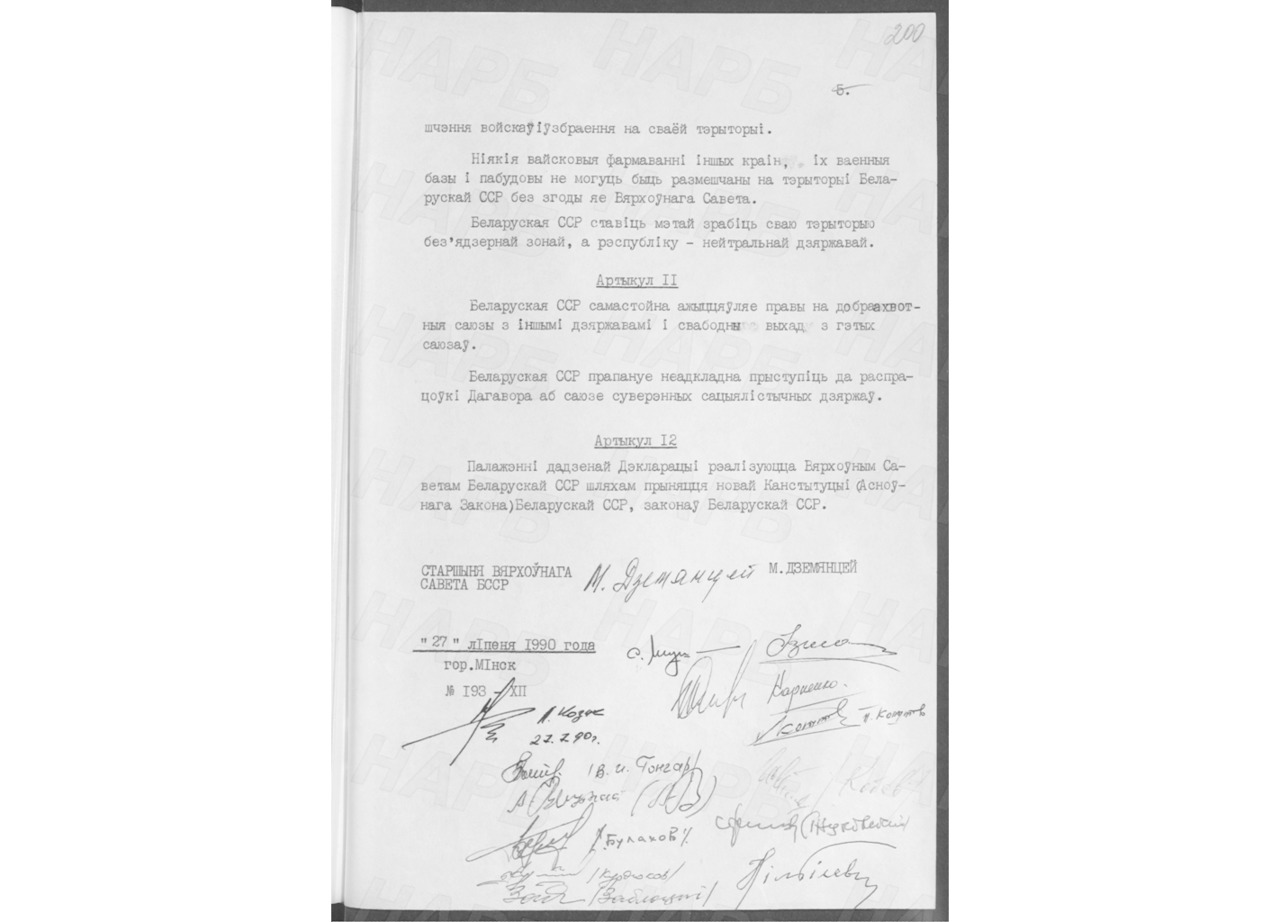
More often than not, an astrologer has to play detective, searching for traces of the event to determine its exact timing.
When researching the signing of the Declaration on the BSSR’s secession from the Soviet Union, I sifted through archives, cross-checked Supreme Soviet session times, and looked into who signed the document and whether any biographical records contained relevant details.
At last I was lucky to find the exact time, it was 8:08 p.m. But a few years later, that information vanished from public records.
Sometimes, as an astrologer, I can not help but smile at the luck when signatories record the exact time of signing historical documents.
For example, the natal chart of Georgia in my collection is reliable because the signatories of the Act of Restoration of Independence recorded the time — 12:30 — on the document.
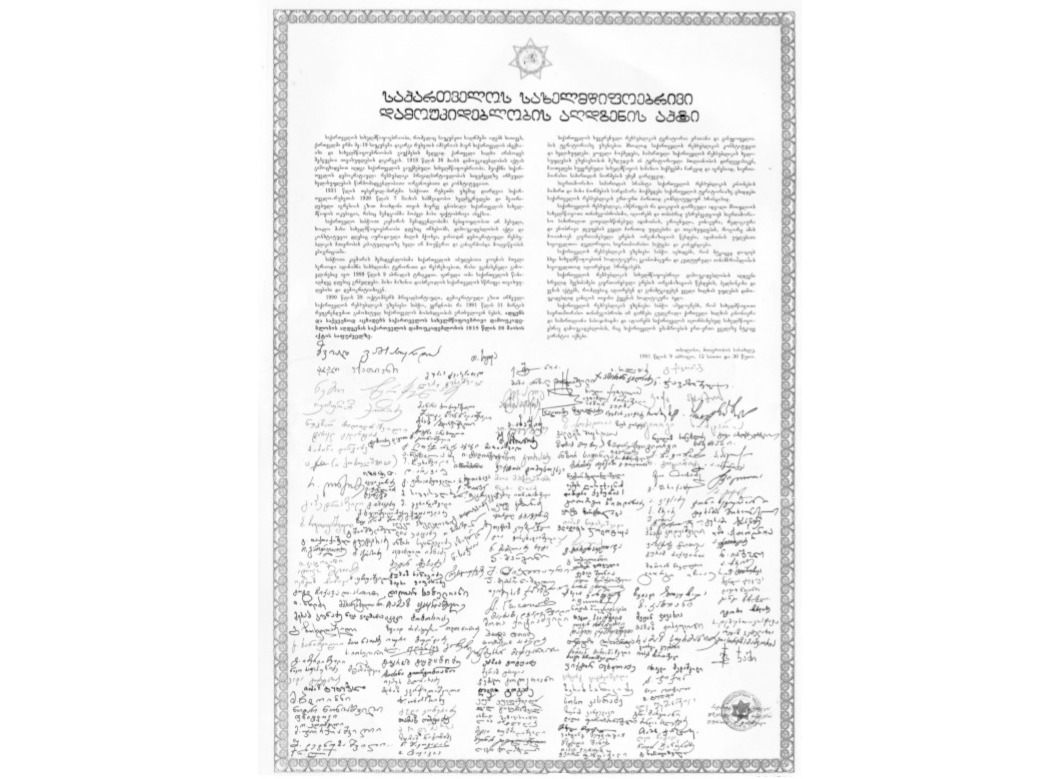
But such cases are rare. Usually the search for an astrological chart is much more agonising and longer, and the effectiveness of it can only be appreciated after a few years.
I have noticed that in socially developed countries, legislation tends to be more precise when it comes to time. Lawmakers passing significant state decisions often make an effort to document the exact time of passage, and these records are well preserved.
The lower the level of social development, the more hidden gaps there are — details that remain impossible to trace. The exact time of when the coup took place remained unclear because there was only the date recorded.
When did the government sign the new constitution? No one knows.
Authoritarian regimes and dictatorships are prone to this. In contrast, democratic nations make information about government decisions and political leaders publicly available. In Western countries, for example, the birth dates of almost every major politician can be easily found on the Internet.
When it comes to the Arab world, the East, and the former CIS, even finding the birth date of a leader can be barely possible. The publicly known birth dates of leaders are routinely altered under various pretexts, especially when the regime starts tightening control. Sometimes, even the year of birth is changed — as in the case of Fidel Castro, who claimed to have been born a year earlier than officially documented.
The biographies of rulers are rewritten, emasculated, personal details are not disclosed, making their fate almost impenetrable for an astrologer. How can you reconstruct the time of birth when you know nothing about the person except the rewritten biography?
Alexander Lukashenko’s birth date has also been changed, and Vladimir Putin is suspected of altering not just his date of birth, but his year of birth as well. However, I do not subscribe to this theory — I find Putin’s birth chart to be entirely functional based on the official date.
By the way, I once encountered an interesting case related to this issue — an astrological chart of Belarus, based on the date of signing the Declaration of State Sovereignty of the BSSR.
On August 5, 1991, during an extraordinary session, the Supreme Soviet of the BSSR adopted a document declaring the state sovereignty, political independence, and economic viability of the Belarusian SSR.
For years, open sources recorded this event with a note along these lines: “The Council members deliberated for an unusually long time, leading to the signing of the document at an unprecedented late hour — 8:08 p.m.” This note remained publicly available until around 2020, but somewhere around 2020–2021, it had mysteriously disappeared. It seems that even in the former CIS, governments have started recognizing the significance of such data.
Knowing the exact data of the formation of the state, we can determine the dates of the beginning of war, political upheavals and much more. Professional astrology is useful to rulers and nations because it provides additional data that cannot be obtained by other methods.
The astrological version of the development of events in the country can be verified by intelligence or additional expert analysis in the direction of the version shown by the chart. Unfortunately, the public tends to have unrealistic expectations of astrology, expecting it to be 100% accurate.
Meanwhile, political scientists, analysts, and even intelligence agencies frequently make incorrect predictions — yet their methods are refined, improved, and passed down to new generations to make them more effective. The same approach should be applied to Mundane Astrology. It should be used for the benefit of one’s country and forecasting techniques should be improved from generation to generation.
Of course, astrology has always attracted frauds and impostors, and it always will. Who do I consider a charlatan? Someone who works without a clear method, without analysis, and without verification.
A professional astrologer works with a structured methodology, tracks their successes, analyzes mistakes, and continuously refines their approach. This is the foundation of progress in any field — including astrology. There is no such thing as complete accuracy in any field of knowledge, yet we continue to develop and refine our understanding.
Astrologers, like professionals in any field, can make mistakes and be as inefficient as any person in the workplace, for there is no employee in the world who is at full resource 365 days a year…
Yet, unlike other professions, astrologers are often given no margin for error. This is because most people believe that prediction is an innate gift or talent — something you either possess completely or not at all.
No, no, and no! Prediction is not magic — it is a precise formula of events found in a natal chart. A method that is reproducible and verifiable.
Proper Forecasting
My students can accurately predict pregnancies, relocations, and other life events down to the exact day. Sometimes, when I am particularly anxious and emotions cloud my professional judgment, I even ask them to make predictions for me.
Their success is not a matter of talent, charisma, or esoteric intuition — it is the result of learning and applying a clear methodology that any rational person can use. I am proud of my students and the techniques we have developed in our Deep Sky Astrology School.
I have noticed a fascinating effect — when you make a long-term prediction (one to three years in advance) and then watch events unfold exactly as forecasted. Each event becomes another piece of the puzzle, fitting together to shape the future. When you know the prediction, you can clearly see where everything is heading. And the opposite — you can handle contradictory news stories that are misleading.
Take, for example, America’s elections in 2016, 2020, and 2024. In each of these cycles, public expectations were manipulated by expert opinions, poll numbers, and media headlines.
In all three elections, I made accurate predictions about who would become the next president.
In 2016, my prediction of Donald Trump’s presidency was made in a week when all major experts gave Hillary Clinton an 80% chance of winning. In February 2020, I successfully forecasted Joe Biden’s victory, selecting him from among three leading candidates. And in July 2024, as soon as the final list of candidates was confirmed, I made my prediction — Donald Trump would win.
For a long time, I have wanted to admit this: no one in the world hopes for a presidential candidate’s victory as much as an astrologer who has publicly predicted it. And it has nothing to do with the candidate’s personality, policies, or strategic vision. It is simply because the astrologer bets their reputation on it.
The 2024 election was the most challenging for me to forecast, and I found myself eagerly anticipating the end of the race. Over the months, I watched as news outlets relentlessly bombarded the public with conflicting narratives, cycling through opposing predictions every 3–5 days.
The sheer number of times they manipulated public opinion, shaped fears and anxieties, and escalated tensions was staggering. The media pushed diametrically opposite headlines, from “Trump will lose in all swing states” to “Kamala Harris has completely destroyed Trump’s ratings.”
Reading such news can send your heart racing — unless you are an astrologer who has already seen the outcome in the charts.
With a clear prediction in hand, the entire media frenzy feels different. You watch it unfold with detachment. No headlines shake you, no polls unsettle you — because you already know the answer.
I take great pride in being an astrologer who has successfully predicted the outcome of three consecutive elections in the United States. In this book, I will also be making many public predictions, and I hope you will follow along and support my work.
These videos with my predictions are still available on our YouTube channel.
(You can watch the video by scanning this QR code. While viewing, subtitles in various languages can be enabled through the settings.)
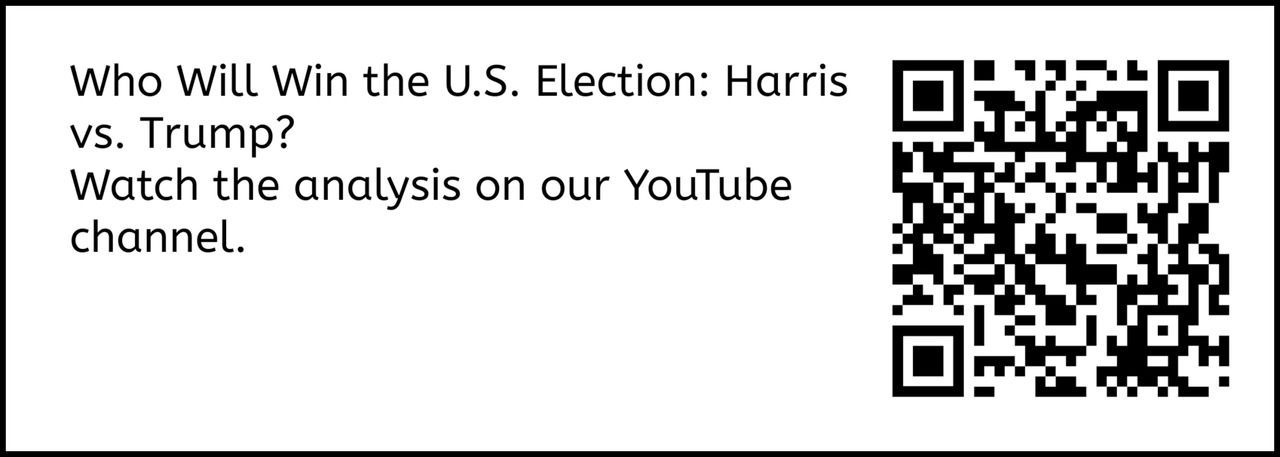
Now, let us return to the question of how an astrologer determines a country’s birth chart.
Amending a country’s constitution does not justify changing its fundamental birth chart. A new chart should only be drawn up in cases of a coup, the country’s dissolution (as with the USSR), or the adoption of a new constitution that fundamentally alters the system of government.
This is usually intuitive to every person who witnesses the events listed. The collapse of the Soviet Union, the secession of republics, a military coup, the transition from monarchy to republic, a revolution, or a new government taking power — are all obvious reasons to compile a new astro chart for the country.
Previous charts will also continue to work and show events. It is worth changing a country’s chart if it is more than 120 years old or if you have doubts about the accuracy of the data for its compilation.
120 years is the length of time in which all nine periods of the planets pass. In the second and even in the third cycle, the chart of a country may partially show new historical events, but still quite detached. The abstraction of the astro chart increases with each planetary cycle of 120 years. Therefore, for such old charts as the natal chart of Great Britain and the USA, I prefer to use annual charts and charts for the beginning of the inauguration of the popular leader.
Every time we establish a birth chart for a country, it is essential to verify its accuracy through a chronological check.
Here is how I do it:
— I draft the natal chart of the country based on the proposed event date.
— I review the country’s recent history, reading through it once to get a general impression.
— I go through it again, carefully analyzing each major historical date in relation to the natal chart. I check when these events occurred, what planetary influences were active, and whether they are clearly visible in the chart.
— I do not just focus on specific dates. Long-term trends, periods of national transformation, economic shifts, and prolonged crises must also be considered. I analyze how these align with planetary periods, zodiac sign periods, and planetary transits.
This process often takes an entire workday. But by the end of it, I have a clear understanding of whether this particular chart accurately reflects the country’s fate, or does not match well. Unfortunately, each country’s chart is a unique and self-contained “ecosystem”. While general astrological principles apply to all, they must always be used with caution. To interpret a country’s birth chart accurately, we must always consider the cultural context and current circumstances.
Let us again repeat the list of charts from which we can infer about life in the country:
— the enactment of the constitution: usually takes effect at midnight on the date specified in the document.
— the time of signing the constitution: if the exact time is recorded or printed on the document, it can be used.
— the proclamation of independence: the moment when the leader publicly declares independence, the referendum concludes, or the results are officially announced.
— the signing of a secession treaty: the time of signature of the document or the time at the beginning of the day on the date of entry into force of the document.
— the signing of a declaration of sovereignty: either the moment of signing or the date it legally takes effect.
— an independence referendum: the moment when voting ends and the results are announced, or when the new status officially takes effect.
— a coup d’état: the exact time the previous leader is removed from power and the new ruler takes control, regardless of the method.
Syria’s Three Constitutions
The Syrian Arab Republic, like many other nations, has multiple charts, each reflecting the country’s fate during a specific historical period.
Syria adopted several constitutions in the 20th and 21st centuries, specifically in 1950, 1973, and 2012. To determine the exact “birth” time of each constitution, let us look at their official texts:
— “This constitution shall enter into force upon its approval and shall be published by the president of the constituent assembly.” (Damascus, September 5, 1950).
— “The constitution shall enter into force on the date of its approval by popular referendum.” (Syria, Constitution of 1973).
— “This constitution shall be published in the official gazette and shall enter into force upon approval.” (Damascus, February 26, 2012).
In other words, the 1950–1973 period should be analyzed using the astro chart of the 1950 constitution. The 1973–2012 period follows the chart of the 1973 constitution. And the current era is governed by the natal chart of the 2012 constitution.
However, each of these constitutional transitions requires thorough historical research, including eyewitness accounts and official records. Unfortunately, such documentation is scarce due to Syria’s strict political regime and the lack of a tradition for recording the exact timing of key state events.
Our saving grace is that most constitutions take effect at midnight, in legal terms, they are considered valid from the very start of that day.
No one debates whether a law was violated before 2:50 p.m. (the moment of ratification) or after — the consequences remain the same. The constitution comes into legal force starting midnight of the date specified.
What About Syria?
Syria is a unique case. For decades, the country has been under the influence of two active natal charts: the chart of the 1973 Constitution and the chart of the coup on November 13, 1970, which marked the beginning of the Assad dynasty’s rule.
On December 7, 2024, the Assad regime fell. The ruling family fled the country, and within hours, rebels seized Damascus — just 11 days into the battle for Damascus.
How was this dramatic turn of events reflected in the 2012 constitution chart?
Case Study 5. Syrian Constitution Chart
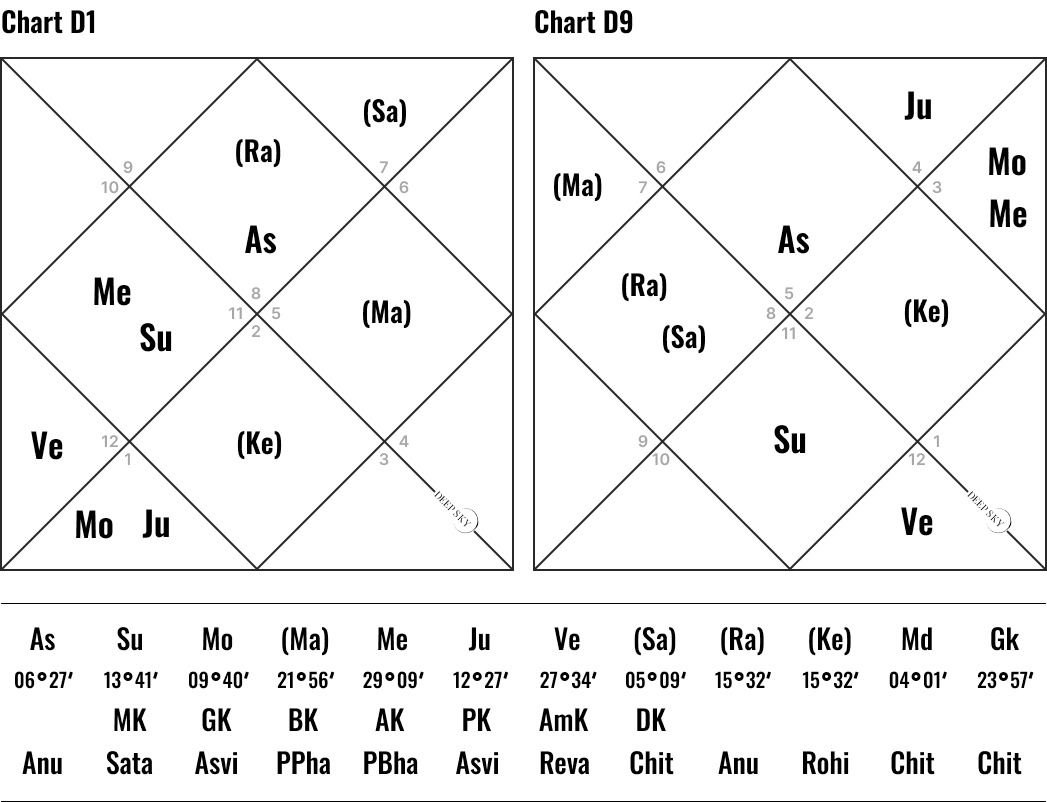
From March 28, 2024, to November 30, 2026, Syria is undergoing a Venus-Jupiter period. While I have not found clear indicators of a leader’s fall through planetary periods, the sign periods provide a strong signal.
The Libra-Leo period lasted from November 29, 2024, to April 28, 2025.
We watch the astrological chart from Leo making it a temporary Lagna and redraw all the planets from this zodiac sign.
The natal chart rotation technique is used throughout this book. And this principle is the key concept in analysing the sign periods of the planets as a whole. A person receives not one, but as many as twelve different charts, which they consistently live through during their life. All twelve characters, which are usually attributed to the signs of the zodiac, are manifested during their life, each in its own period.
During the period of Leo, which took place at the time of the military coup in Syria, the ruler of the tenth house (authority and leadership) was placed in the eighth house of crises. Besides that, Ketu in the tenth house speaks of missing and abdication of power. What comes after Assad’s fall?
From February 2026 to February 2033, Syria will enter a Virgo period. This term is expected to be weak, as few active planets indicate a lack of strong direction or decisive leadership. However, Bhatri Karaka Mars in the twelfth house suggests that this period will be far from peaceful…
Venus from the temporary lagna is exalted in the seventh house, but it is conjunct the star Bayten-Keitos in the constellation of Cetus. It can bring: “Fatal changes, depression, danger of death. Humiliation, denials and obstacles.”
In other words, the coming six years will be turbulent and unstable in Syria, filled with dangerous clashes and repeated breaches of peace in the country.
In the third house of media from Virgo is placed Rahu. It shows that the media will be controlled by the military and used as a tool of influence.
Saturn in the second house points to serious financial difficulties. In general, exalted Saturn in the house of money and resources often creates the effect of “sitting on a bag of money but unable to use it.”
A military dictatorship will take deeper root — this is what awaits Syria in the coming years.
But could this country live any differently? The astrological chart of the current constitution clearly reflects totalitarianism:
— the rising sign is Scorpio, ruled by Mars — a sign of military power and restriction under the influence of a watery sign, dictatorship and control.
— Mars in the tenth house of power shows that future rulers will rely on military force, and military coups are likely. Being a malefic planet in the tenth house in a fixed sign, Mars also indicates a historical trend toward authoritarian and totalitarian leadership, where rulers are not replaced for long periods.
— Ketu in the seventh house points to the handling of peace and war through terror, espionage, and guerrilla tactics.
— the third house of media is ruled by Saturn, which signals that the media is entirely controlled by the regime.
— Rahu in the first house, the house of the state itself, suggests foreign influence, dependency on outside forces, and the presence of outsiders within the country.
— Gaja Kesari Yoga (an auspicious conjunction of two benefic planets) appears in the sixth house, but instead of softening its effects, it amplifies the themes of the house, encouraging conflict, hostility, and internal confrontation.
Of course, this natal chart also has some very positive planetary positions:
— Venus in the fifth house points to the country’s rich culture and beautiful, vibrant youth. But its conjunction with the twelfth house of foreign lands suggests that many young people will seek to leave the country.
— the conjunction of the Moon and Jupiter, despite being placed in a difficult house, indicates that Syria can still play an important role on the international stage. Unfortunately, that role is more like that of a vassal to stronger neighbors, who use Syria to advance their own interests.
With such an astrological chart, Syria can hardly hope for a bright future. But what I hope for is that, over time, the Syrian people will find a path toward progress, one that will bring with it a stronger chart, with better periods and real opportunities for growth.
Nation’s Charts.
European Union
The first in our collection of country natal charts is the astrological chart of the European Union (EU).
Case Study 6. Natal Chart of the EU
It is based on the date the Maastricht Treaty came into force — November 1, 1993, at midnight. Location: Maastricht, Netherlands.
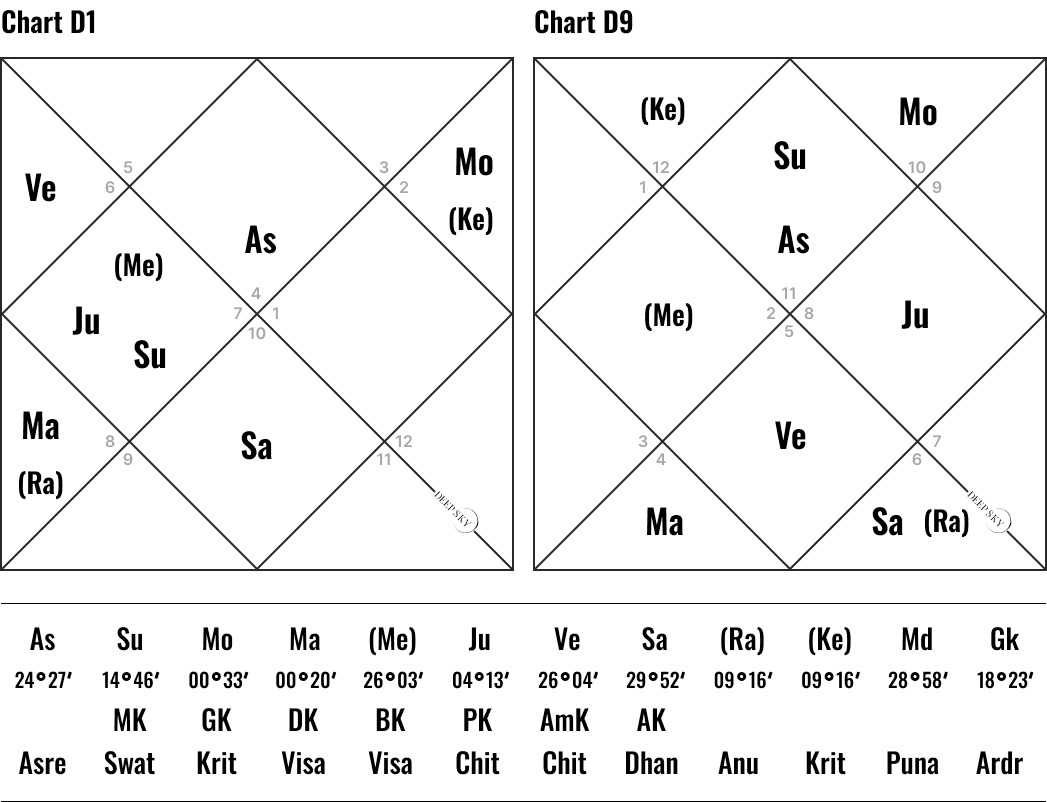
A striking feature of this chart is that the ruler of the entire astrological chart is placed in the eleventh house — the house of alliances, unions, and collective goals. This clearly reflects the essence of the moment: the formation of a union of states.
The rulers of the third and eleventh houses, along with the planets located in the eleventh, often define the nature of the alliance itself. that can be the following:
— Rahu and Mars point to military objectives or alliances formed around defense and strategic power.
— Venus and the Moon suggest a foundation based on shared values, cultural closeness, and ideological alignment.
— Mercury indicates alliances focused on trade, commerce, and economic cooperation.
— Jupiter reflects legal and judicial collaboration, alliances grounded in law, ethics, and mutual regulation.
— Ketu shows partnerships formed around cutting-edge technologies, cyberspace, artificial intelligence, science, and innovation.
— the Sun is rarely involved in the creation of alliances. In my observation, the Sun represents centralized power and is more associated with dominance, where a stronger partner absorbs a weaker one, rather than with balanced, cooperative unions.
— Saturn often shows up strong in the astro charts of unions and alliances. It is the planet of structure, regulation, and order. In alliances, strong Saturn acts as the binding force between member states. It shapes shared institutions, formal processes, and represents the day-to-day machinery of joint governance.
In charts for alliances that bring together many countries, it is actually common to see debilitated planets. You would expect the natal chart representing 27 nations to be overwhelmingly strong — but it is not.
In the EU’s chart, the Sun is at its weakest position, sitting in Libra, in the nakshatra Swati. This reflects a key idea: EU members willingly give up part of their personal authority for the sake of cooperation, unity, and mutual support.
Later in this book, you will see birth charts of authoritarian leaders, where the Sun is usually in a powerful position. By contrast, in the charts of democratic leaders and unions, the Sun is often weak which is a sign of diplomacy and a willingness to share power.
The third house, which rules borders and communication, is also weakened — Venus is in fall there. At the same time, there is a mutual exchange between the rulers of the third of borders and fourth houses of territory, which clearly shows how internal EU borders are open, while its external ones are tightly controlled.
Venus in Virgo is a perfect symbol of the EU’s rigid, detail-heavy application process, with its multiple levels of review and strict standards. The Moon, the ruler of the whole chart, is in the eleventh house of alliances, and it is exalted in Taurus — a powerful placement.
Between January 27, 1998, and January 27, 2008, twelve countries joined the EU: Estonia, Latvia, Lithuania, Poland, the Czech Republic, Slovakia, Hungary, Slovenia, Cyprus, Malta, Bulgaria, and Romania. That was the largest expansion in the EU’s history.
Let us take a look at the EU astrological chart for 2004 (technically from November 1, 2003 to November 1, 2004).
Case Study 7. Annual EU Chart: 2003–2004
Venus stands out in the D-1 chart (the main natal chart), the D-9 (which complements the main chart) and the D-4 (focused on land and territory). In all three of them, it forms a Raja Yoga — a powerful combination related to success — and in every case, it is connected to the eleventh house, the house of alliances, unions, and collective goals.
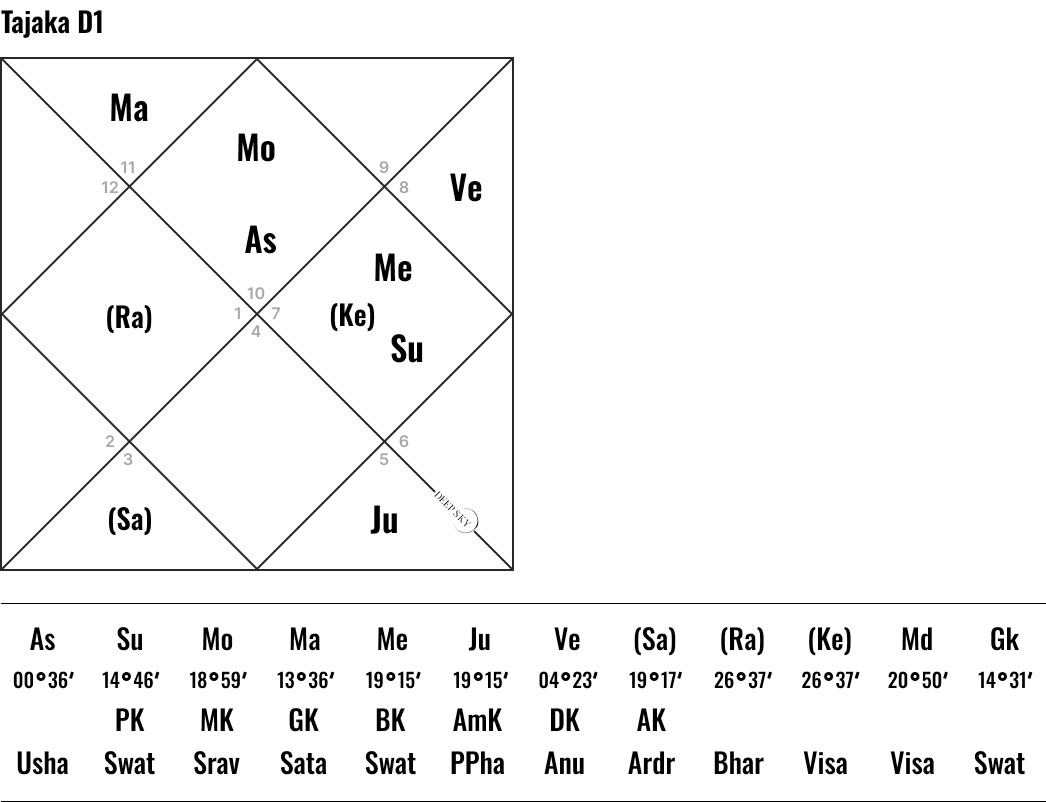
Venus naturally represents peace, unity, and cooperation. So it is no surprise that the EU’s 2004 annual chart clearly pointed to a major event: the accession of ten new member states.
We will take a closer look at how this expansion shows up in the astro charts of those countries in the next chapters.
The Moon period from 1998 to 2008 was not smooth sailing for the EU. The Moon is sitting in the eleventh house, but it is right next to Ketu, which is often associated with economic pressure, restrictions, and crisis.
During that time, the EU had to deal with two global economic shocks, while also shouldering the weight of social spending for its newest, less wealthy members. It was a tough stretch — one that really tested the Union’s resources and internal balance.
The Moon is positioned close to one of the most malefic stars in the sky which is Algol, located in the constellation of Perseus.
Algol is traditionally associated with retribution, legal prosecution, and downfall. As soon as the Moon period began, there was a collective resignation of the head of the European Commission, Jacques Santer, and the 19 remaining members following allegations of fraud.
It is remarkable how consistently Algol shows up in national astrological charts — almost always signaling trials, persecution, and the downfall of prominent figures.
The Mars period, which ran from January 27, 2008 to January 27, 2015, saw an attempt to establish a common European constitution. But that effort ultimately stalled, as it was not ratified by all EU members.
The idea of a shared constitution was first launched at the EU summit in December 2001, during the Moon — Jupiter period. Jupiter, being the ruler of the ninth house of law, diplomacy, and foreign policy, and a natural significator of legal matters, made this initiative a predictable outcome of that alignment.
Maha Dasha of Jupiter begins in January 2033, and it is very likely that this will mark the formal adoption of a pan-European constitution.
For the first time, banknotes and coins of the new Euro currency were introduced into circulation on January 1, 2002. At that time, the EU was in the Moon — Jupiter period. Jupiter as part of a Raja Yoga involving the rulers of the second house of money and the ninth house.
It is likely the launch did not take place during the Sun period, because the Sun is debilitated in the chart. But a successful and strong neighbor helped the ruler of the house of money and manifested a common currency for all allied countries.
In the D-9 chart, Jupiter is also the ruler of both the second and eleventh houses, once again linking money and alliances.
Mars holds a particularly telling position in the EU’s chart. Since the Union is a collection of territories acting as one, Mars as the natural indicator of land and property is strong and functions as the Raja Yoga Karaka.
It is placed in the fifth house, which governs colonies, extensions, and subsidiary lands. This placement clearly shows that the EU is, among other things, a territorial association.
Mars as the Raja Yoga Karaka is also a recurring feature in the astro charts of countries that have joined the EU. It reflects their potential to become part of a larger territorial structure and to benefit from EU membership, especially through freedom of movement within the expanded territory.
Mars as the Raja Yoga Karaka often appears in the annual charts of countries during the year they join the European Union.
The Rahu Maha Dasha, which began on January 28, 2015, set the tone for the EU’s development over the next 18 years. It clearly points to a future where Europe is filled with foreigners and outsiders.
Already in the fall of 2015, the EU faced a migration crisis, triggered by a dramatic rise in the number of refugees and undocumented migrants entering the Union.
Rahu is also positioned next to the star Bungula, part of the Centaurus constellation. Stars like this are part of a new branch of astrology, which you can read more about in the book Deep Sky Astrology.
Bungula is a star associated with sudden and unexpected breaks in relationships. Right as the Rahu period began, the United Kingdom voted to leave the EU, and by the end of the first sub-period of Rahu — Rahu in January 2020 Brexit was finalized. The UK became the first country to exit the European Union after 47 years of membership.
These two themes — a growing influx of migrants and the sudden rupture of long-standing partnerships — will likely remain relevant throughout the entire Rahu period, lasting until at least January 2033.
It is also fascinating to see how the COVID-19 pandemic shows up in the EU’s natal chart. The Union entered a Rahu — Saturn period on March 4, 2020, just 12 days before a full lockdown was imposed across Europe.
In this chart, Saturn is the ruler of the eighth house, the house of crisis, trauma, and upheaval. It is placed in the seventh house, disrupting peace and balance in the country.
Saturn in this chart is stationary — it had just stopped before turning direct. This occurred on October 28, 1993, just three days before the Maastricht Treaty came into effect. It takes Saturn about three days to return to its normal speed, meaning that at midnight on November 1, the moment the EU was officially formed, Saturn was essentially motionless.
During Saturn’s sub-period, we saw the visible world in the Eurozone come to a standstill — empty streets, no crowds in cafes or restaurants, no traffic during rush hour. The lockdown froze life in Europe for many long months.
The seventh house in a country’s astrological charts reflects both peace and disturbances of peace within the nation. In this case, Saturn revealed itself through military involvement in managing the epidemic — military field hospitals, curfews, city control, and the enforcement of citizen isolation.
I have noticed that in the natal charts of developed countries, damage to the seventh house tends to manifest in a milder form, as it did here. But in the third world countries any affliction to the seventh house often leads to military escalation, revolutions, or other severe crises.
The more developed a country is, the less vulnerable it is to military catastrophes. This is something astrologer-forecasters must consider — and they should look for alternative causes of unrest when interpreting the seventh house in such charts.
For example, we now know for sure that when Ketu influences a country through the Vimshottari Dasha, and there is disturbing the peace in their astro charts through the damage of the seventh house, this can point to epidemics, national isolation, and attempts to maintain control through military measures.
Likewise, malefic influences on the third house do not always indicate conflict with neighboring countries. They may also reflect situations such as border closures or the suspension of civilian movement, especially in the context of epidemics or sanctions.
Predictions for the European Union
The European Union is currently in a Rahu — Mercury period, which lasts from January 11, 2023, to July 31, 2025. Mercury is retrograde, and in this context, it reflects the state of the EU’s energy resources, which are limited at this time. Why? The answer lies in Mercury’s placement in the nakshatra Vishakha.
The deity presiding over Vishakha Nakshatra is Indra, king of the gods, who also rules Jyeshtha. Vishakha, under Indra’s influence, carries a subtle sense of pride and seniority, which can make individuals or nations influenced by it feel superior and act accordingly. Yet at its core, Vishakha remains peaceful and inclined toward reconciliation between opposing sides.
Vishakha is also associated with sanctions. Its ruling planet, Jupiter, governs the sixth house (sanctions and legal disputes) as well as the ninth house (diplomacy and jurisprudence) in this chart. As a result, Mercury is weakening because of the indicators of both of these houses.
From July 31, 2025, to August 19, 2026, the EU enters a Rahu – Ketu period. Ketu is located in the eleventh house of Parliament, which will bring meaningful changes to the European Parliament, despite the fact that elections have already been held in 2024 and this convocation has been approved until 2029.
Ketu represents separation, disconnection, and reduction. In the eleventh house of alliances and unions, its influence can signal tension or a breakdown in cooperation with one or more allies.
Ketu is placed in the nakshatra Krittika — a solar nakshatra associated with separation and cutting away. Its symbol is a blade, a knife. The core idea behind Krittika is to cut off what no longer serves a purpose, to strip away the unnecessary, and to complete unfinished work by clearing out what is in the way. Krittika burns through anything that will not be used.
That is why I would not be surprised if, during the Ketu period from July 2025 to August 2026, the EU begins shedding excess — cutting budgets, reducing salaries and bonuses, and trimming back wherever it can.
And most important — from the summer of 2025 the EU will be threatened by the prospect of economic crisis and lack of resources, because Ketu stands in the house of savings and wealth. The same downward trends will apply to relationships with partners, spending on alliances, partnerships, and the like.
If we turn to the EU’s annual chart for the period from October 31, 2024, to October 31, 2025, here is what we find.
Case Study 8. Annual EU Chart: 2024—2025
In the EU’s annual chart, Saturn is conjunct with the star Hydor, which lies in the stream of Aquarius. This alignment may signal the possibility of water-related disasters affecting EU territory.
The Muntha is positioned in the eighth house of crisis, indicating a stressful and turbulent year. That house is heavily afflicted by both Saturn and Mars. That means, in 2025, the changes in the EU are going to be very significant and dramatic indeed.
One of the year’s most striking features is Mars in fall, placed in the first house, while also being the ruler of the tenth house of power and governance.
Based on this position, I believe that EU leadership may be compromised in 2025, triggering talks of re-election or leadership reshuffling.
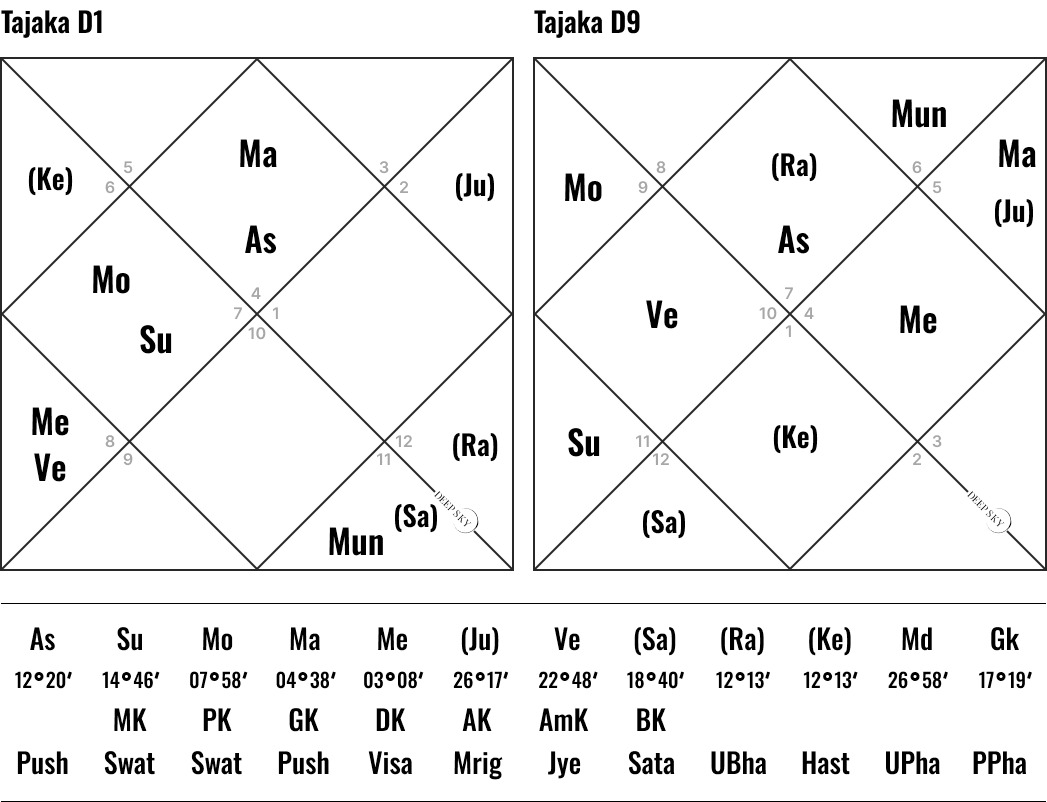
On February 23, 2025, Germany, the EU’s leading country, will hold a snap election for chancellor… In this case this chart omen concerns the change of political course of Germany within the European Union.
Mars in this placement also emphasizes issues related to military affairs and armaments, likely bringing disputes, disagreements, and tensions across the Union. The maximum scenario of how Mars can harm the EU in 2025 is a dramatic change of leading personas in the union.
Additionally, Mars rules the fifth house, which relates to culture, sports, the arts, and intellectuals. This suggests that the events of 2025 may negatively impact these sectors as well.
The ruler of the second house of finance is also in fall, which indicates that 2025 will be a financially weak year for the EU.
Unfortunately, the outlook in the annual charts for the following years does not appear much more optimistic.
Next, let us look at the annual chart covering the period from November 1, 2025, to November 1, 2026.
Case Study 9. Annual EU Chart: 2025—2026
We can see two debilitated planets that are related to the second house, the house of finance, which indicates that the financial condition of European countries will be weaker than usual during this year.
At the same time, Jupiter is exalted in the eleventh house of alliances, suggesting a warming of relations with partners and pointing to the possibility of a new alliance or a new candidate for EU membership.
Mars and Mercury are both strongly placed in the third house, but they occupy a specific zone known as Sarpa Drekkana — a degree linked to restriction and control. This has a direct connection to sanctions, meaning that in 2026, EU trade and economic activity will still be heavily constrained and affected by sanction regimes.
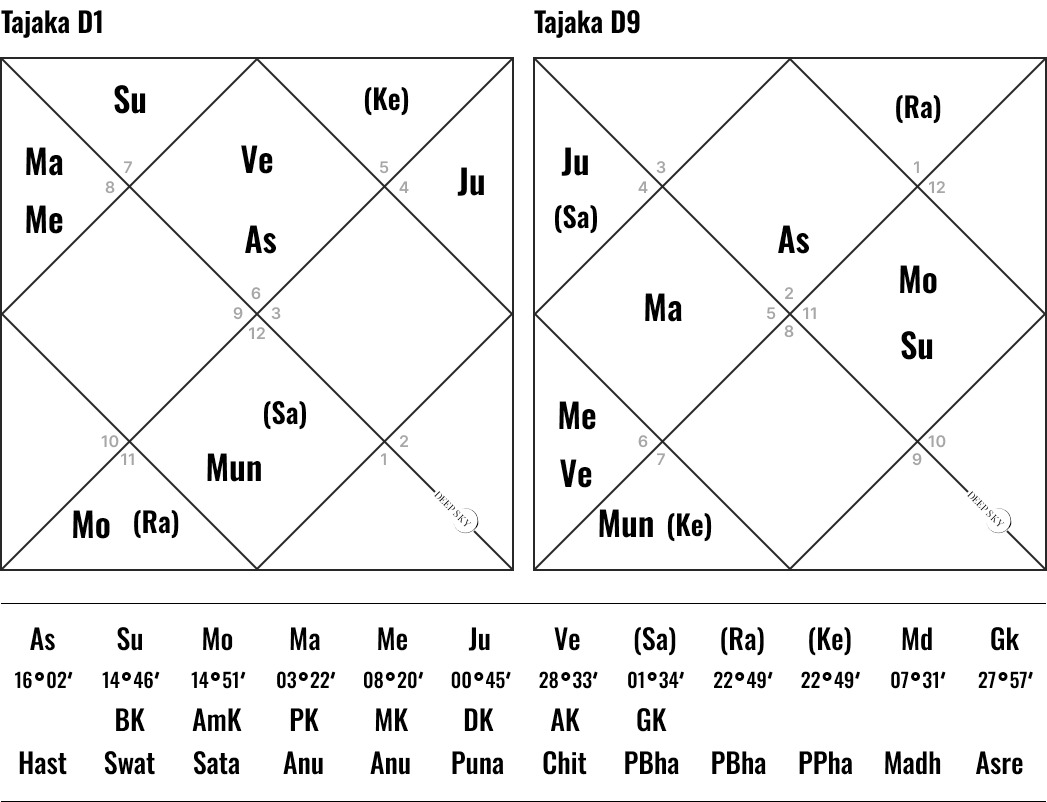
Case Study 10. Annual EU Chart: 2026—2027
In 2027 (according to the EU’s annual chart from November 1, 2026, to November 1, 2027), the ruler of the first house, Mars, is in fall and placed in the ninth house of diplomacy. This again points to international tension, sanctions, and potential conflicts, along with signs of aggression.
One particularly interesting factor in this chart is the opposition between Pluto and the Moon along the 3–9 house axis. Pluto is a symbol of conflict and upheaval, while the Moon represents the well-being and everyday life of the population.
In this year, Jupiter’s favorable position will provide additional funding. Positioned in the tenth house of power, near the royal star Regulus, Jupiter highlights the EU’s prominence on the global stage and reinforces its influence in international politics.
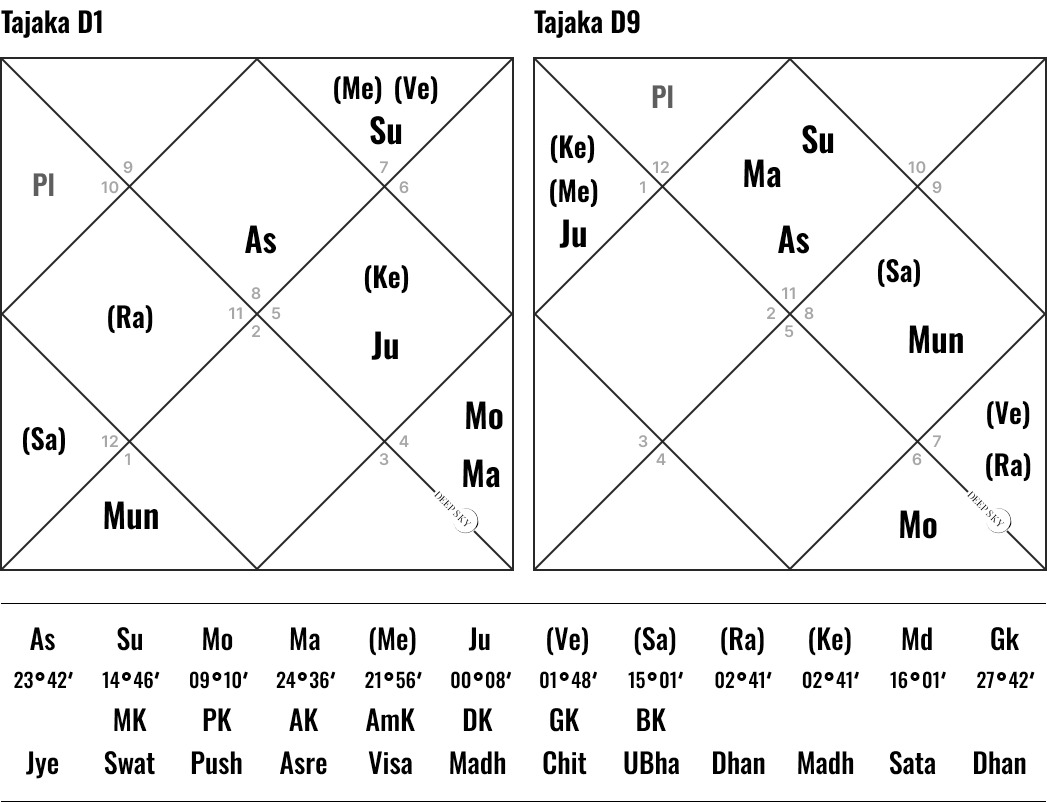
The EU’s diplomatic success is further supported by the placement of Venus, Mercury, and the Sun in the twelfth house, which governs foreign affairs and international engagement.
Venus is placed close to Arcturus, in the constellation of Boötes, Mercury is close to Zubenelgenubi or the Southern Claw. Both stars are very favorable, speaking of success and leadership.
When we analyze the natal chart of unions or associations, we operate on the level of ideas and values. At this level, nakshatras become especially meaningful, offering rich, symbolic insight into the events unfolding within these large-scale structures.
Moreover, understanding that, in such astrological charts, we are dealing with long-term trends stretched out over time.
It is no secret that the smaller the living organism, the faster its metabolism and the shorter its lifespan — a bacterium lives hours, a mouse lives a few years, while an elephant may live 60 to 70 years.
By the same principle, the larger the state or alliance, the slower its inner processes unfold. These dynamics accumulate gradually, often culminating in a defining moment or historical event.
The Maha Dasha (period) of planets or signs shows the general direction and development of these long-term trends, while the Antar Dasha (sub-period) marks the moment those trends break through and become visible on the surface of history.
Nation’s Charts. Germany
The astrological chart of Germany is strikingly similar to the natal chart of the European Union. It often happens that the chart of a creation mirrors that of its creator.
In my personal collection of astrological data, I have gathered three astrological charts for Germany, each of which deserves special attention in its own right.
The first natal chart covers the period from August 14, 1919, through 1933.
This phase begins with the enactment of the Weimar Constitution and continues up to Hitler’s inauguration, which marked the beginning of a new chapter in German history — Nazi Germany.
Case Study 11. Natal Chart of Germany
The position of Saturn in Leo is particularly noteworthy — the German Socialist Republic was proclaimed following the fall of the King of Prussia, the result of an anti-monarchist uprising. Saturn’s placement in Leo, the sign of kingship and authority, reflects the restriction and dismantling of the ruling class.
Let us see how brilliantly the chart shows the power structure in this country.
The legislative branch (eleventh house) was represented by two bodies: the Reichsrat (Imperial Council), composed of delegates from the state governments, and the Reichstag, elected by citizens through universal, equal, and direct suffrage by secret ballot.
The head of state (tenth house) was the Reichspräsident, elected by the people.
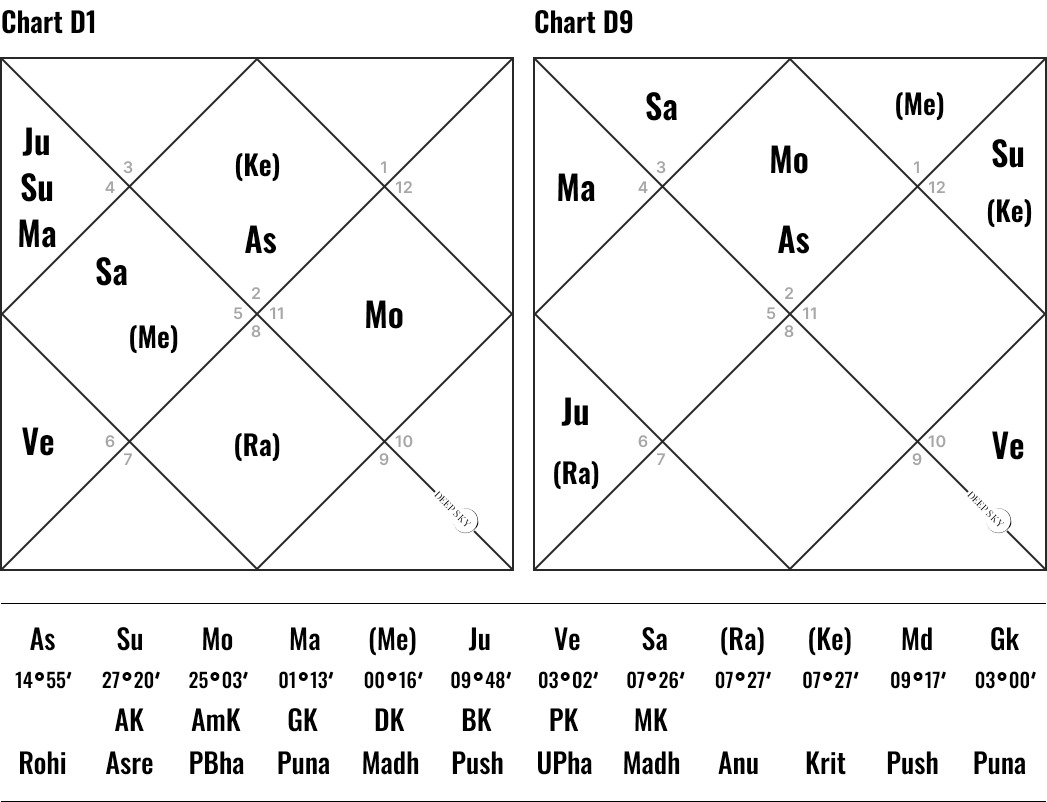
Executive power rested with the Reichsregierung (Imperial Government), made up of the Reich Chancellor (Reichskanzler) and Imperial Ministers (Reichsminister). The President of Germany (Reichspräsident) appointed the government (tenth house), but it was accountable to the Reichstag (eleventh house).
So, how is this seen in the chart? The Reichstag is obviously the eleventh house, as it serves as parliament. In the chart it is ruled by a strong, exalted Jupiter in the third house — an ideal placement for a legislative body. Jupiter is powerful, though it sits next to hostile Mars, hinting at military coups that threaten the republican idea of the state.
In the end, this is exactly what unfolds: a military coup brings a totalitarian leader to power, one who would turn the world upside down in 1939.
The ruler of the tenth house representing the Reich Chancellor and his Ministers is Saturn which greatly limits the powers of the executive. Saturn is placed in the house of opposition, suggesting protests and resistance. In any case, Saturn’s influence over the tenth house imposes strict limits on the executive power.
However, Saturn is also a Raja Yoga Karaka, and in the second half of the republic’s life, this will give the executive more strength.
Mercury. The country entered the Jupiter – Mercury period, marking a kind of “restart.” Mercury, located near Saturn, indicates continued civil unrest and protest. It also reflects separatist tendencies, since Mercury rules the fifth house of disputed and subsidiary territories and is afflicted by Saturn.
On January 10, 1919, the Bremen Soviet Republic was declared, only to be dissolved shortly after by troops from Berlin. A little later, the Bavarian Republic also shared the fate of the Bremen Republic.
During the Mercury period, the Treaty of Versailles was signed, resulting in Germany losing territories and colonies, and being forced to pay reparations.
Also under Mercury, a referendum was held on July 11, 1920, after which the districts of Allenstein and Marienwerder remained part of Prussia. Mercury is conjunct Saturn, ruler of the ninth house, which is a classic indicator of a popular vote.
More broadly, the German Socialist Republic experienced major territorial shifts between 1918 and 1921, consistent with Mercury’s position in the fourth house (land and territory) near restrictive Saturn.
Mercury is retrograde and sits at the very beginning of its sign, meaning it has not yet gained full strength — this contributes to the difficulties the country experienced under this period.
Ketu. Mercury’s period was followed by Ketu’s period in the first house of prosperity of the entire nation. Ketu indicates sanctions and exclusion.
It is important to remember: when Ketu appears in the first house of a politician’s chart, it often signals persecution, loss of civil rights, and pariah status. The same effect can be observed at the national level, which is exactly what the astro chart revealed in this case.
Venus. Now, let us turn to Venus, which is in fall — a major and recurring feature of German astrological charts.
In a nation’s chart, Venus governs the arts, social policy, and justice. When well-placed, Venus brings cultural richness, fairness in governance, artistic achievement, and a higher quality of life.
A strong Venus in annual charts often signals peace treaties or ceasefires. When Venus and Jupiter — two benefic planets — are coming together, they have the power to halt wars.
On the other hand, a debilitated Venus often corresponds with currency devaluation (as was the case when the German mark was eventually abolished with the introduction of the euro), collapsed peace agreements, worsening social programs, or imbalanced governance.
In the birth charts of rulers, a weakened Venus is often a sign of cruelty and political terror.
In this chart, Venus, like Mercury, is in the fifth house, which relates to disputed territories. This reflects events between May 1921 and February 1924, when Germany continued losing territories. In fact, there was even a foreign occupation.
In January 1923, French troops occupied the Ruhr region in response to Germany’s delayed reparations payments — this marked the beginning of the Ruhr Crisis.
Mars. The Mars period that followed served as the impulse behind the Weimar Republic’s entry into the League of Nations and the signing of the Locarno Treaties. Mars ruled the period from March 15, 1926, to February 20, 1927.
Although Mars is the planet of war, in this chart it is debilitated in Cancer — perfectly reflecting the disarmament mission of the League of Nations.
Mars is located in the third house of neighboring countries, conjunct exalted Jupiter, which rules the eleventh house of alliances. With Jupiter in such a strong position, forming an alliance during this period was more of an astrological pattern than a coincidence.
Rahu. Ketu in the first house and Rahu in the seventh house of war reflect Germany’s military potential, militaristic attitudes, and a desire to shed its pariah status and reclaim power.
In 1929, these tensions came to the surface in what is now remembered as “Blutmai” (Bloody May). During a May Day demonstration — held in defiance of a ban on public gatherings — police opened fire on peaceful protesters, killing 33 people and injuring more than 20.
Rahu, ruled by a debilitated Mars, brought about a disturbance of public peace and terror within the country.
Jupiter. The years 1924 to 1929 are often referred to as the Golden Twenties or Happy Twenties, when the Weimar Republic experienced relative stability, economic recovery, and growing international recognition.
It was the second half of Jupiter’s period. The astrological chart of Germany is marked by both an exalted Jupiter — an indicator of wealth — and a debilitated Venus, which points to a harsh social policy that constantly goes beyond the bounds of balance and proportion.
Venus in Virgo can also help explain certain cultural features often attributed to Germany: a preference for practicality over beauty, rigid discipline, and punctuality — all classic expressions of Venus in this sign.
Interestingly, the Jupiter period that lasted from 1919 to 1929 gave parliamentary authority the upper hand over the executive branch. But with the start of the Saturn period, the power of the Reichstag began to wane.
Saturn, as a Raja Yoga Karaka, strengthened the ninth house (judiciary) and the tenth house (executive power). Their conjunction in the chart favors the merger of these branches into one and contributes to the formation of a totalitarian state.
Saturn. The collapse of the Weimar Republic came during the Saturn – Mercury period, when Adolf Hitler became Reich Chancellor.
The influence of the only truly benefic planet in this astro chart Jupiter had ended, and not long after, the Republic gave way to totalitarianism.
This outcome could easily have been foreseen: the onset of Saturn’s period in Leo signaled the rise of radical nationalist ideologies. But it is essential to distinguish between Saturn in Leo and Saturn as Raja Yoga Karaka.
Case Study 12. Adolf Hitler’s Inauguration Chart
According to the astrological chart for the moment the ruler takes the solemn oath of office, we can trace future events in the country, the direction of the government during each astrological period, and its overall effectiveness.

The chart of Adolf Hitler’s rule begins under the rising of the Hyades, an asterism in the constellation of Taurus.
The Hyades are known for giving noble intentions that end in collapse and disappointment. This star group has a dark legacy in world history — Venus was conjunct the Hyades in the U.S. annual chart for 1945, which foreshadowed a major military confrontation and the use of nuclear weapons. Mars conjoined the Hyades in 1962, during the peak of the Cuban Missile Crisis, also known as the Caribbean Crisis.
This chart begins in the nakshatra Krittika, whose symbol is a blade or knife. The theme of weapons is embedded into the very foundation of Hitler’s political era.
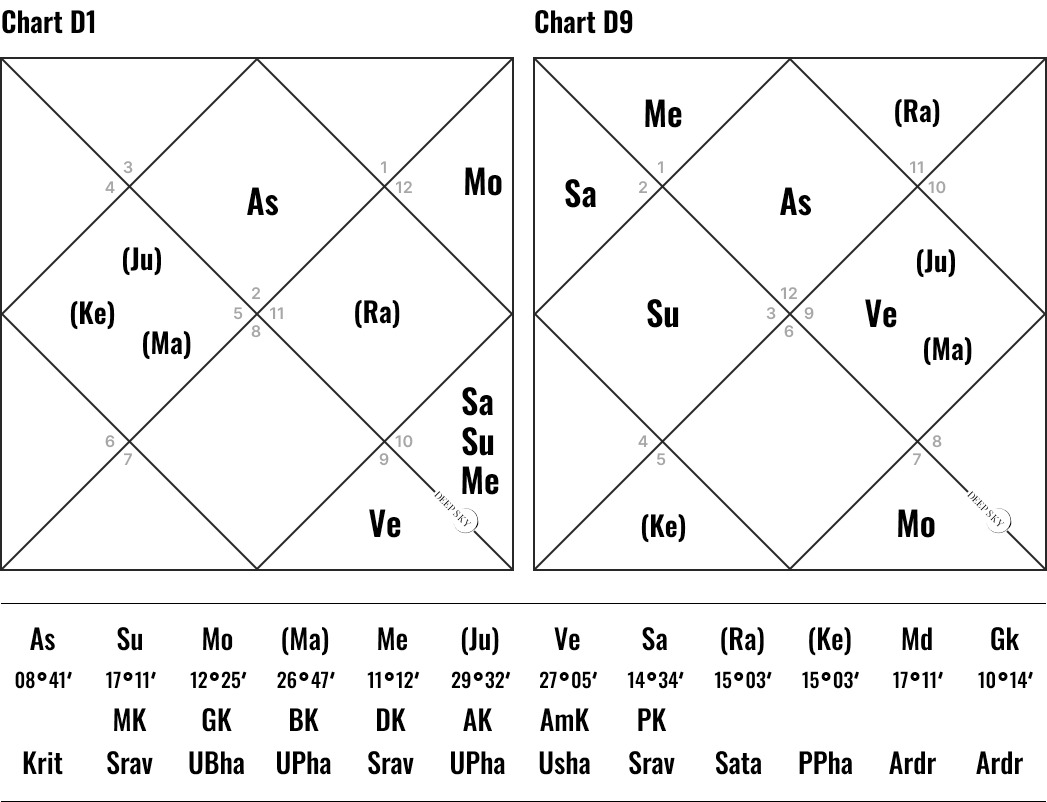
Venus, the ruler of the entire governing chart, is placed in the eighth house, the house of crisis and death. Venus in Sagittarius reflects ambition and idealistic goals. The placement of the ruling planet in the house of death is no coincidence — Hitler was obsessed with the belief that Germany must either rise to greatness or be destroyed. As the years passed, the theme of death grew louder, gradually embedding itself into Germany’s ideology, culture, and policies.
The eleventh house, representing parliament, is weak. It contains a changeable Moon, contributing to an unstable legislative body, and its ruler is retrograde — signaling that the Reichstag would be weak and subordinate to the head of state’s authority.
By contrast, the ruler of the tenth house of power is Saturn, which in this chart is a Raja Yoga Karaka in its own sign — a very powerful placement. Saturn is positioned in the ninth house, indicating the regime’s strong focus on foreign policy, and a certain subordination to a higher ideological or judicial authority. From the ninth house, Saturn aspects the eleventh house, effectively controlling the Reichstag.
Hitler’s inauguration is a textbook example of the rise of a totalitarian regime: a weak fourth house of opposition, a strong ninth house of ideology, and Rahu in the tenth house, amplifying power, influence, and manipulation.
Case Study 13. Natal Chart of Germany: 1933—1945
The astrological chart of totalitarian Germany can be drawn for the moment the Enabling Act was passed — the law that effectively terminated the Weimar Constitution and granted the Reich Chancellor unchecked power, allowing him to pass laws without the Reichstag or constitutional procedure.
This law, formally titled “The Law to Remedy the Distress of People and Reich”, was enacted on March 24, 1933.
It modified the traditional system of separation of powers by giving the government legislative functions. It is an important fact that the Imperial Government could legislate on the same subject as the Reichstag, thus following only National Socialist legislation, which took precedence.
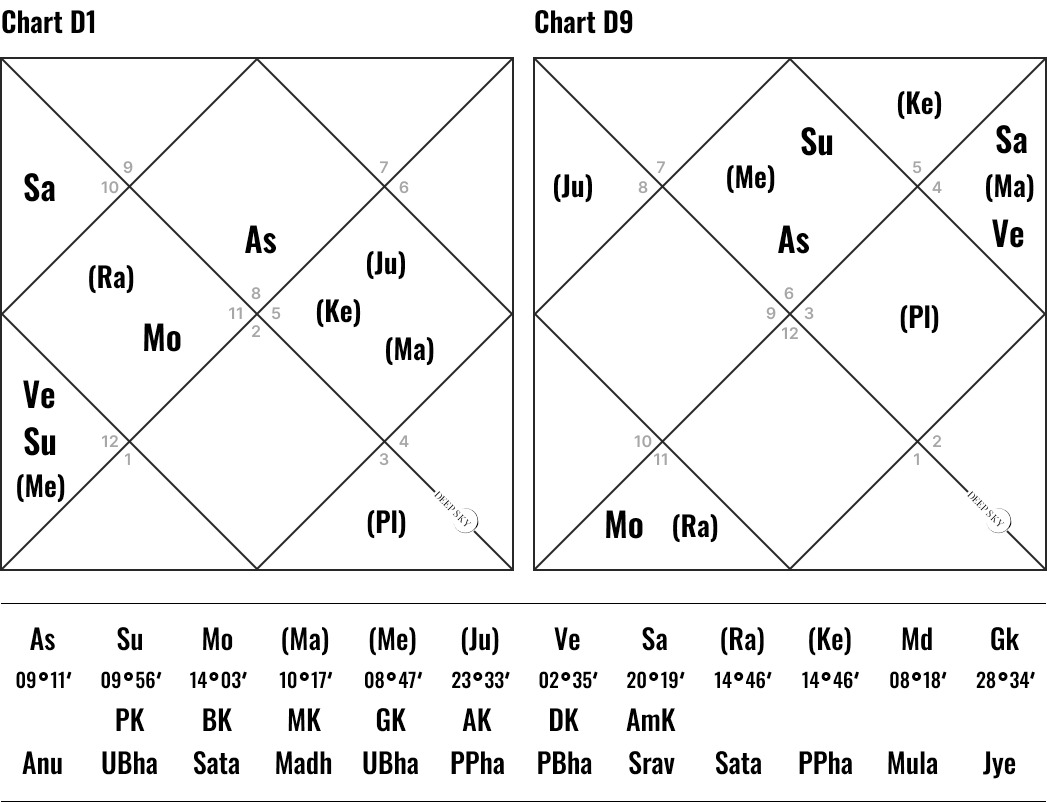
This is the moment we use to construct the chart of fascist, totalitarian Germany.
Let us look at the key astrological indicators of this kind of astrological charts:
— Mars as ruler of the first house and Scorpio sign within the first house immediately gives a hint of dictatorship of military forces in the country. The Ascendant is in Sarpa Drekkana, symbolizing internal control, repression, and future sanctions.
Mars is placed in the tenth house of executive power, highlighting the cult of military dominance and the ruler’s personality — Mars sits in Leo. Nearby are Jupiter, the planet of ideology and power, and Ketu, representing the secret police, covert operations, and hidden mechanisms of control.
— the Moon is deeply afflicted in the fourth house, representing the state of domestic opposition — wounded and weakening, just like a waning Moon. The mutual placement of Jupiter and the Moon reflects the regime’s reach and recognition in foreign affairs as the Moon rules the ninth house of international politics. However, retrograde Jupiter reveals that this rise was unstable and short-lived.
— the cluster of planets in Leo points to the intense cult of personality of the ruler.
The fifth house, associated with disputed and captured territories, is filled with Venus, the Sun, and Mercury — a configuration that allowed Germany to occupy entire nations. However, during Mercury’s period, which began in December 1945, Germany lost all of its conquered lands.
It is worth overlooking a 6–7 month discrepancy in this state astrological chart. For a political entity as large and complex as an empire, such a minor inaccuracy is astrologically negligible.
Mercury, as ruler of both the eighth house of death and the eleventh house of alliances, signals how Germany’s allies turned away in 1945, and how the state ceased to exist in the form outlined by this chart.
Pluto’s position in the eighth house foretells a short lifespan for this regime. Whenever Pluto transits the eighth house, its aspects to the cusp of the eighth house or the eighth house ruler gives a period of trials for the country, threatening the collapse of statehood.
Pluto stays in a single zodiac sign for about 20 years, and its original placement in the eighth house confirmed the brief, destructive lifespan of Totalitarian Germany.
We will return to the subject of the fall of empires in a separate chapter devoted entirely to that theme.
The start of World War II coincided with the Rahu – Moon period. The Moon — the symbol of peace, Bhatri Karaka.
During the Rahu – Mars period, Germany’s military achieved major victories. In the Jupiter – Jupiter period, Germany reached its territorial peak, holding vast occupied regions. But in the Jupiter – Saturn period, everything collapsed.
From 1945 to 1949, Germany entered the era of division, and for that, the next national astrological chart begins in 1949.
Case Study 14. Natal Chart of Germany: 1949—1990
This is the natal chart of the Federal Republic of Germany (FRG), set for midnight on May 23, 1949. On this pivotal day in Bonn, which was then the capital of West Germany, the Basic Law was adopted — a document that would become the foundation of the country’s legal and political system.
After years of dictatorship, a devastating world war, and total collapse, the drafters of the postwar constitution succeeded in laying the groundwork for a new order based on democracy and freedom.
So what does a nation’s astro chart look like after a catastrophe — after sanctions, occupation, and the global infamy of having sparked a war that lasted more than five years?
The ruler of the first house Jupiter is debilitated and retrograde, it is placed in the second house. This reflects Germany’s deep postwar financial crisis, and the burden of reparations owed to affected nations.
Saturn remains in the sign of Leo, which is a recurring feature in Germany’s charts. However, in this chart, Saturn is not functioning as a Raja Yoga Karaka. It limits the power of the elites, which, in the context of postwar reconstruction, ultimately benefits the country as a whole.
Rahu in the fifth house and Ketu in the eleventh point to the continued presence of foreign military forces on German soil.
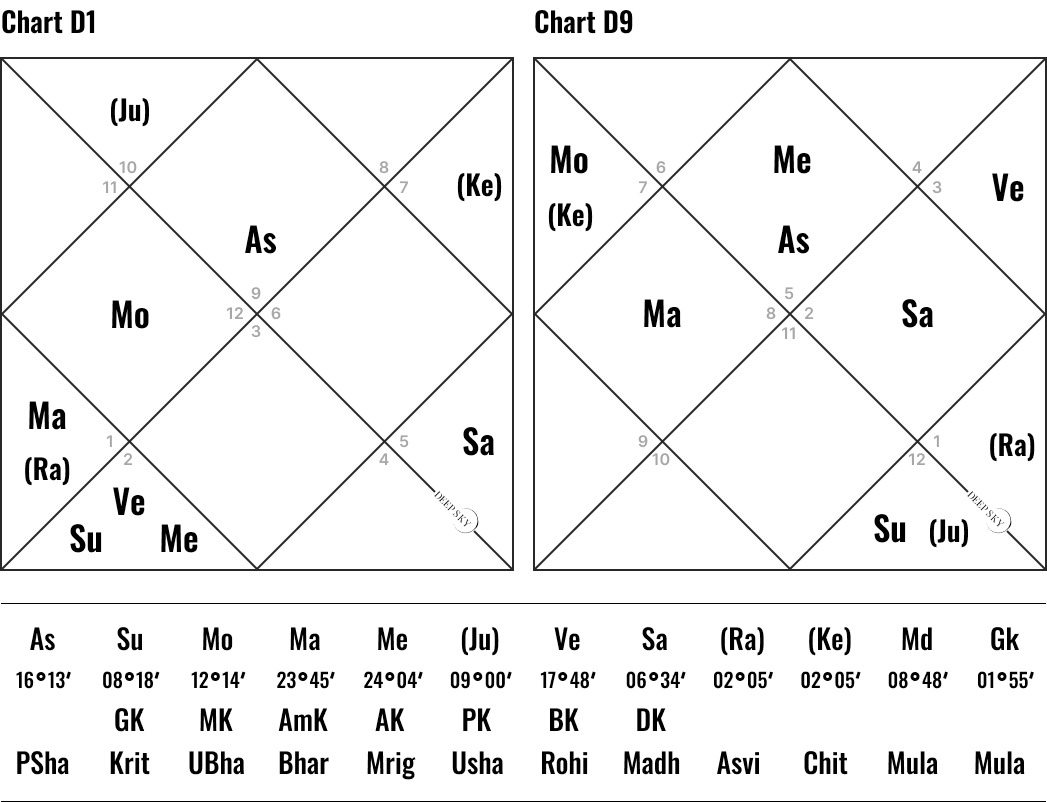
Until 1955, during the ongoing Saturn period, the FRG remained focused on restoring international trust. This is symbolized by Saturn’s position in the ninth house, the house of foreign policy and diplomacy. The nation’s primary task during this time was to rebuild international relationships and reclaim its position as an equal among European countries.
When the Mercury period began in September 1955, lasting until September 1972, the FRG experienced a wave of progress. The FRG joined NATO. Mercury, located in the sixth house of defense and rearmament, sits beside the ruler of the eleventh house, which governs alliances and treaties. Venus in a strong position supported stability and peace. The Sun, also positioned in the sixth house, underscored the need for military reform.
This period also marked the rise of the Miracle on the Rhine — the rapid and successful rebuilding of Germany’s economy after World War II and the creation of a modern, highly efficient industrial state.
Then the Venus-Jupiter period began from November 1989 and the country united, ushering in a new historical milestone in this land.
Jupiter as ruler of the fourth house showed the solution to the problem of Germany’s territorial and political division.
Case Study 15. Natal Chart of Germany: 1990-Present
The astrological chart of modern Germany is drawn for October 3, 1990, midnight in Berlin, marking the official reunification of the Federal Republic of Germany (FRG) and the German Democratic Republic (GDR).
An exalted Jupiter in the first house is a powerful indicator of the nation’s well-being and its authority on the global stage. This Jupiter placement — exalted and positioned in Dig Bala — perfectly reflects Germany’s prominent role as a leader within the European Union.
Mars, functioning as a Raja Yoga Karaka (signifying land and territorial influence), sits in the eleventh house of associations, suggesting that Germany remains the core around which other nations gravitate. Meanwhile, Rahu and Ketu on the 1–7 house axis signify that Germany’s military potential is still present, and may resurface more visibly in the future.
Currently, Germany is in a Mercury period. Mercury is exalted, but surrounded by malefic planetary influences, which weakens its positive effect. Until 2036, Germany is likely to remain a dominant force in Europe, but its neighbors will continue to be problematic, generating tensions and instability around it.
From 2036 to 2043, Germany will enter its Ketu period. During this time, the country may again find itself seen as a controversial actor on the world stage, with its policies and actions subject to international criticism. Sanctions or diplomatic pressure are a distinct possibility.
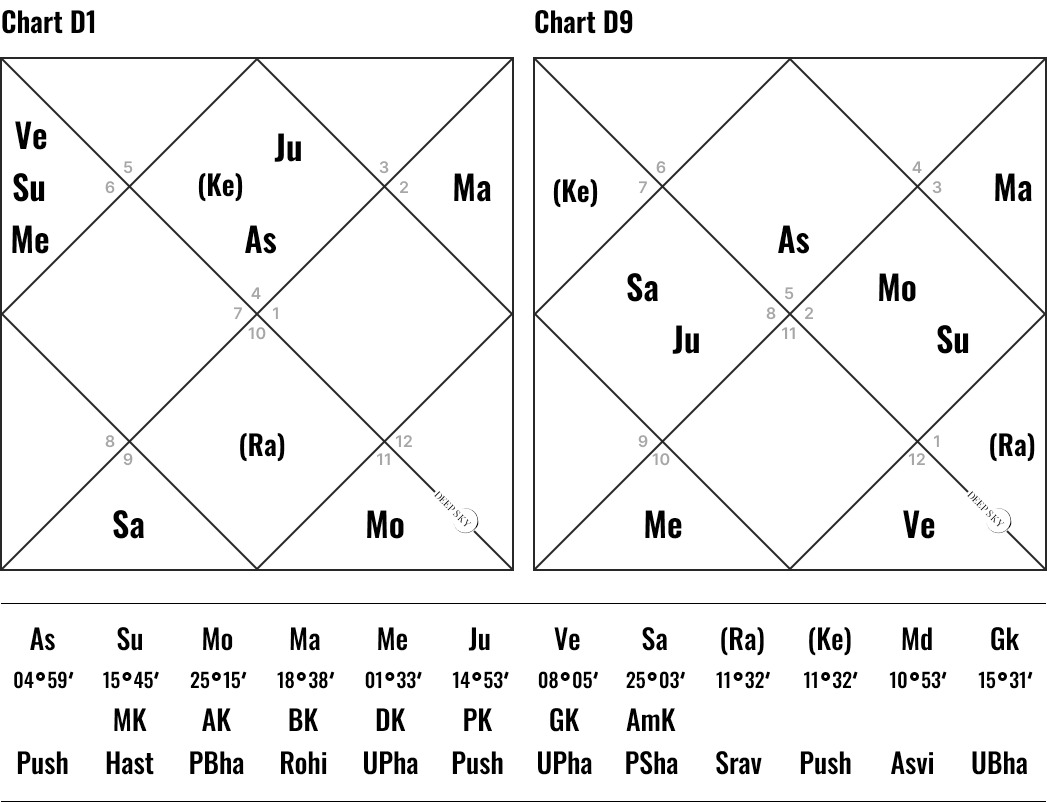
The year 2041 stands out as a particularly difficult time: Pluto will transit through Germany’s eighth house of death and transformation, triggering political upheavals that could seriously threaten the nation’s structure and even its territorial integrity.
This Ketu period in the 40s, compounded by Pluto’s challenging transit, will be followed in 2043 by the Venus period, which points to a withdrawal from alliances and unions. Given the deep astrological ties between Germany and the EU, the year 2041 will also mark a crisis of cohesion within the European Union.
In short, the period from 2041 to 2043 looks to be critical for Germany, that will lead to a change of order and geopolitical perturbation of Europe after the collapse of the European Union.
Let us return to the European Union chart.
Nation’s Charts.
European Union
Case Study 16. Natal Chart of the EU
The first signs of a crisis in the EU’s integrity will appear from August 2026 to August 2029. During these three years, Venus will bring disputes over new members and tensions with allies.
Бесплатный фрагмент закончился.
Купите книгу, чтобы продолжить чтение.
